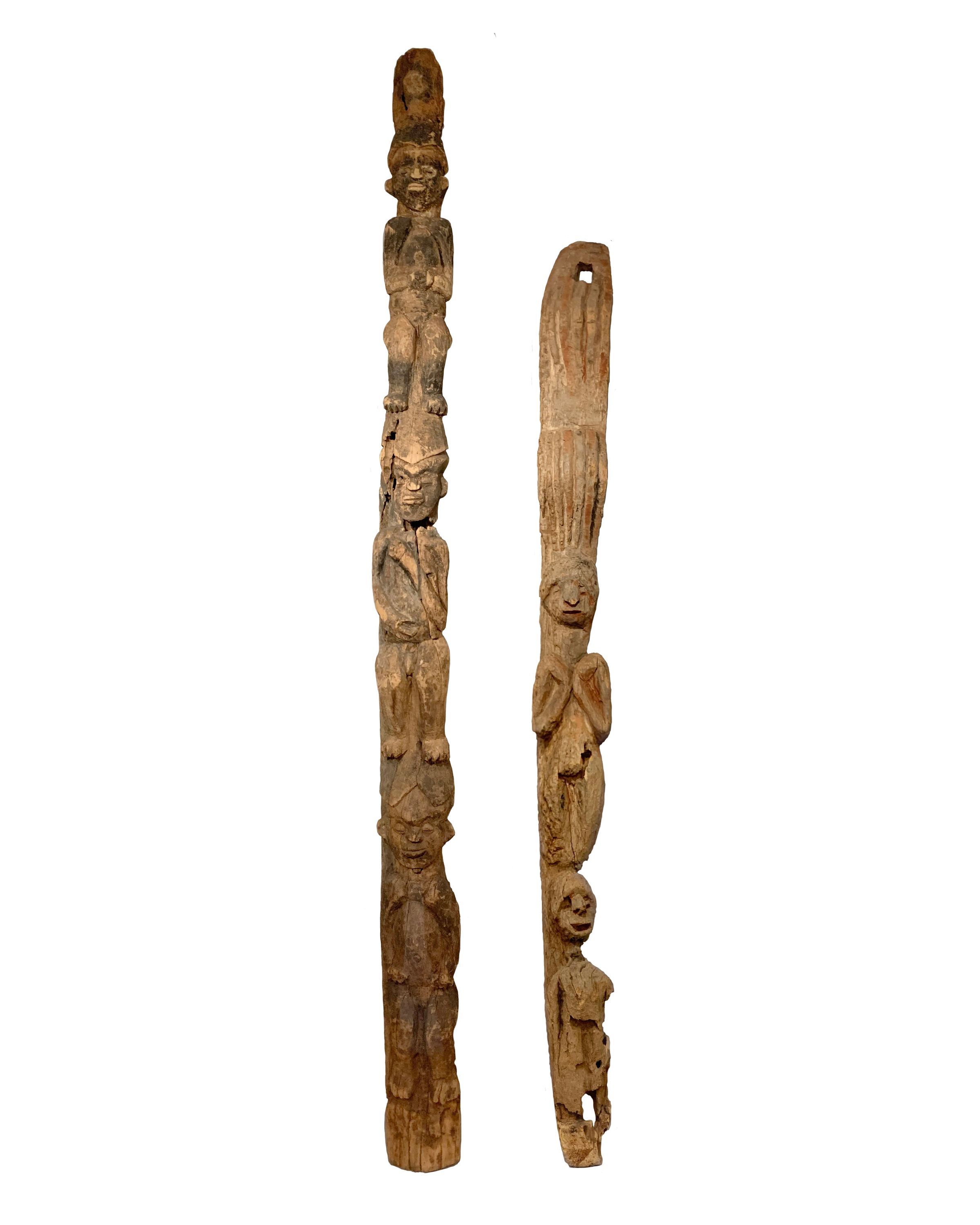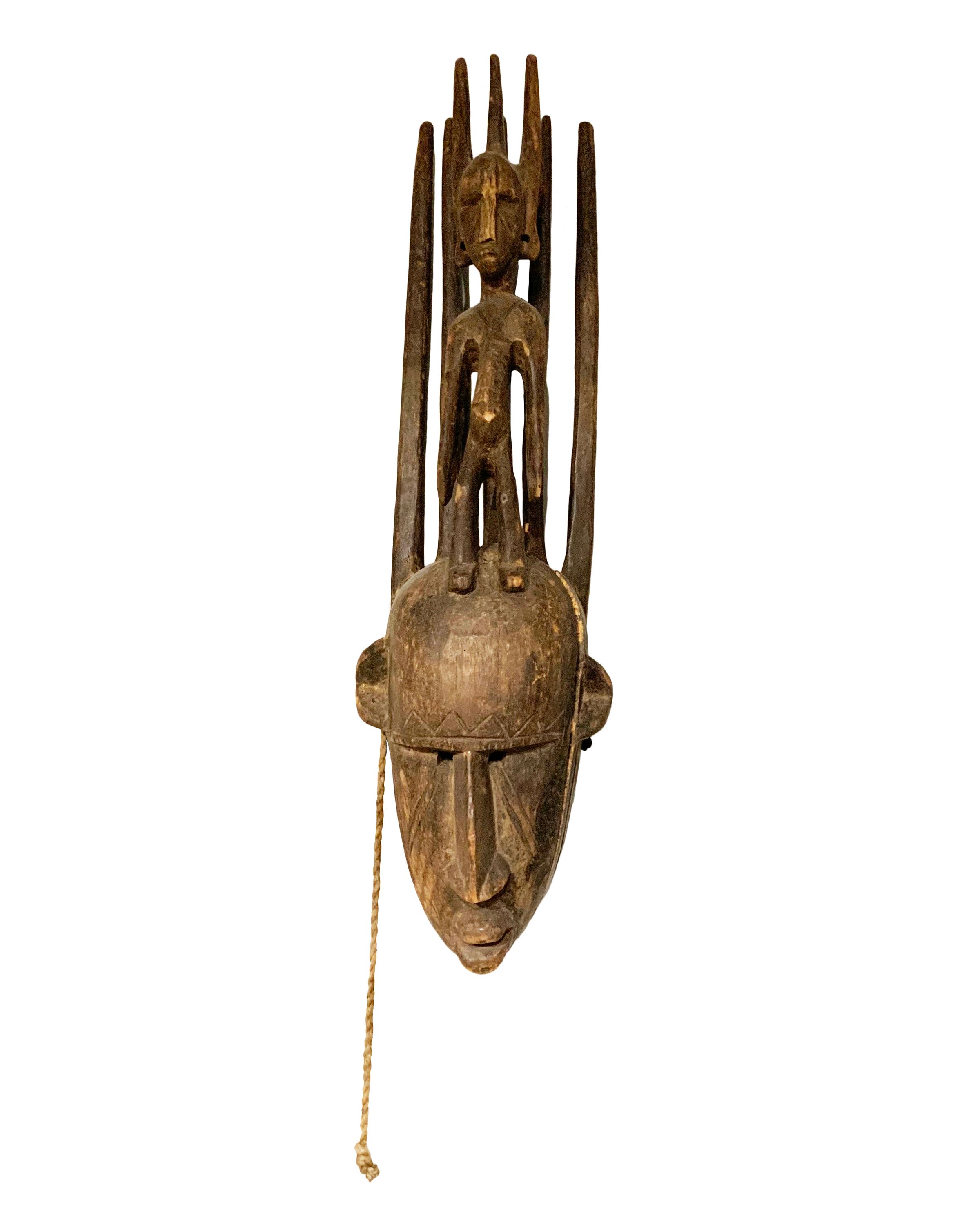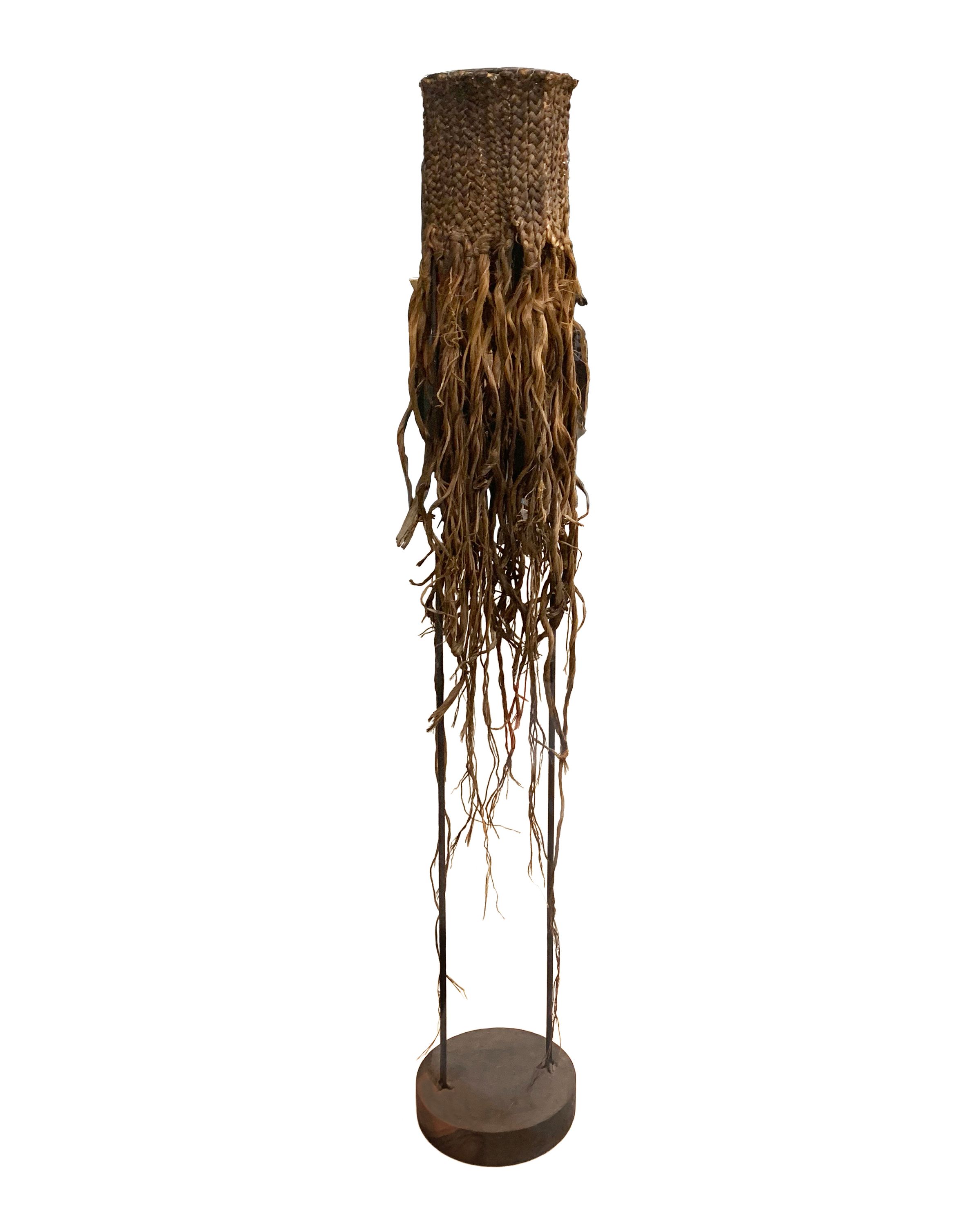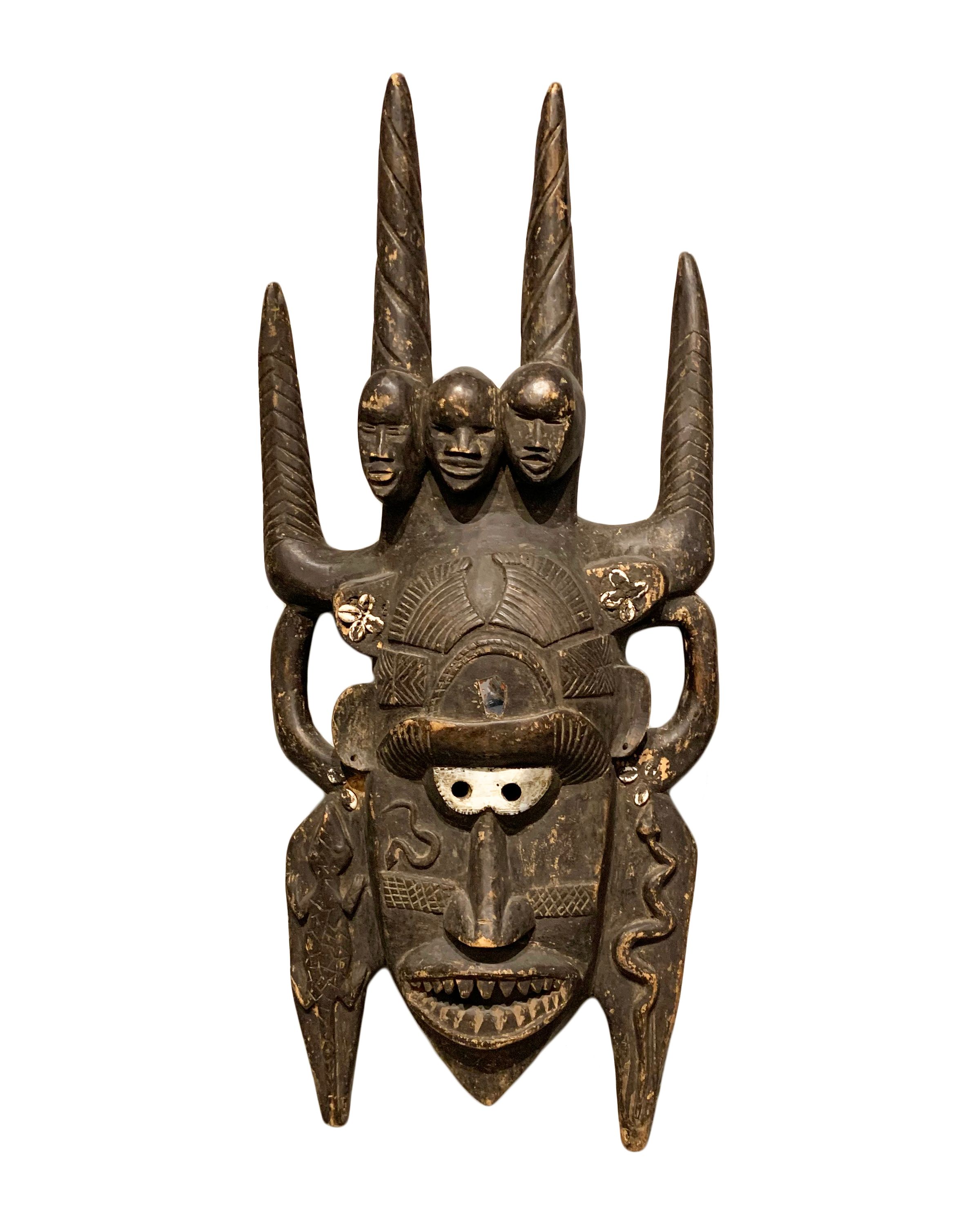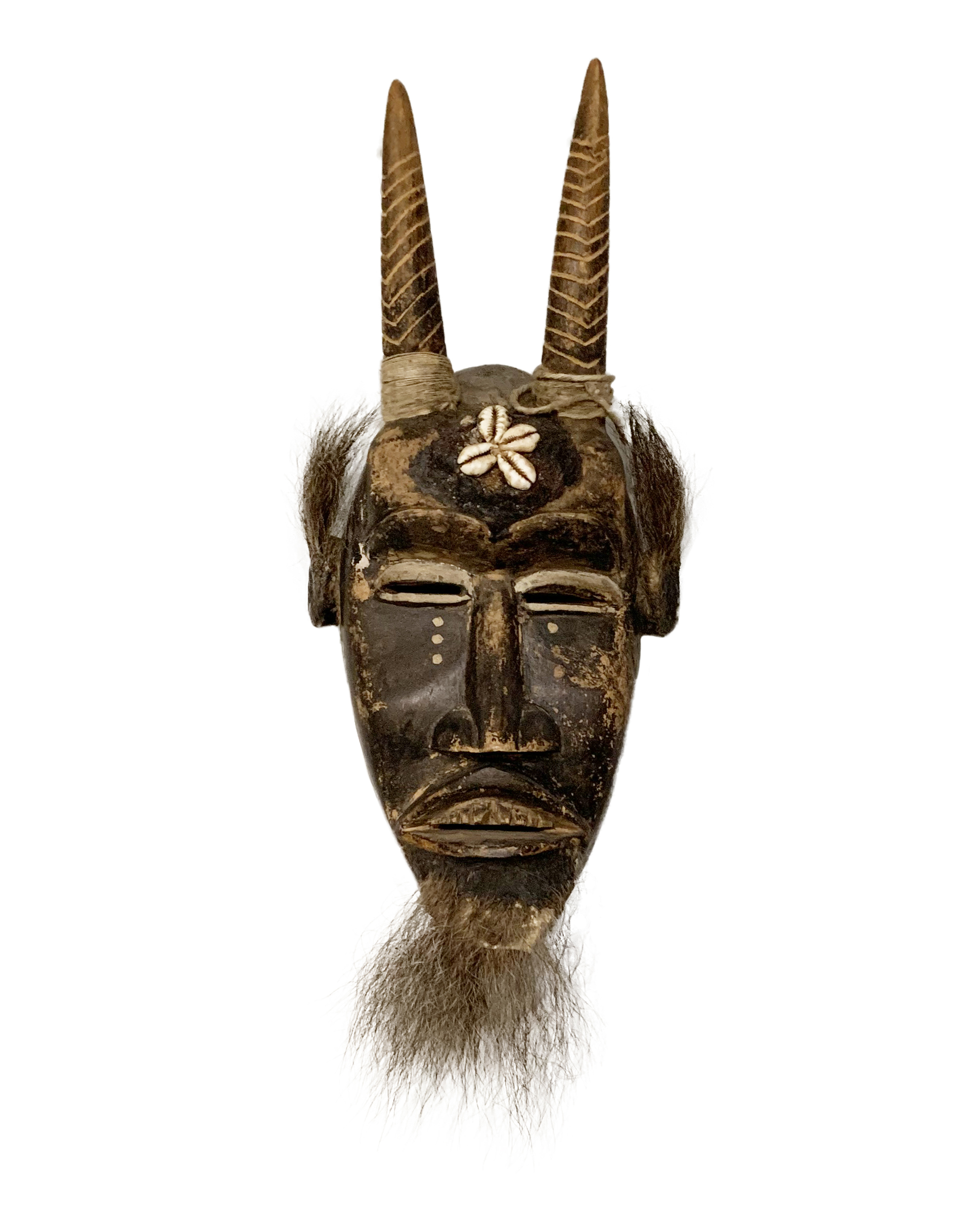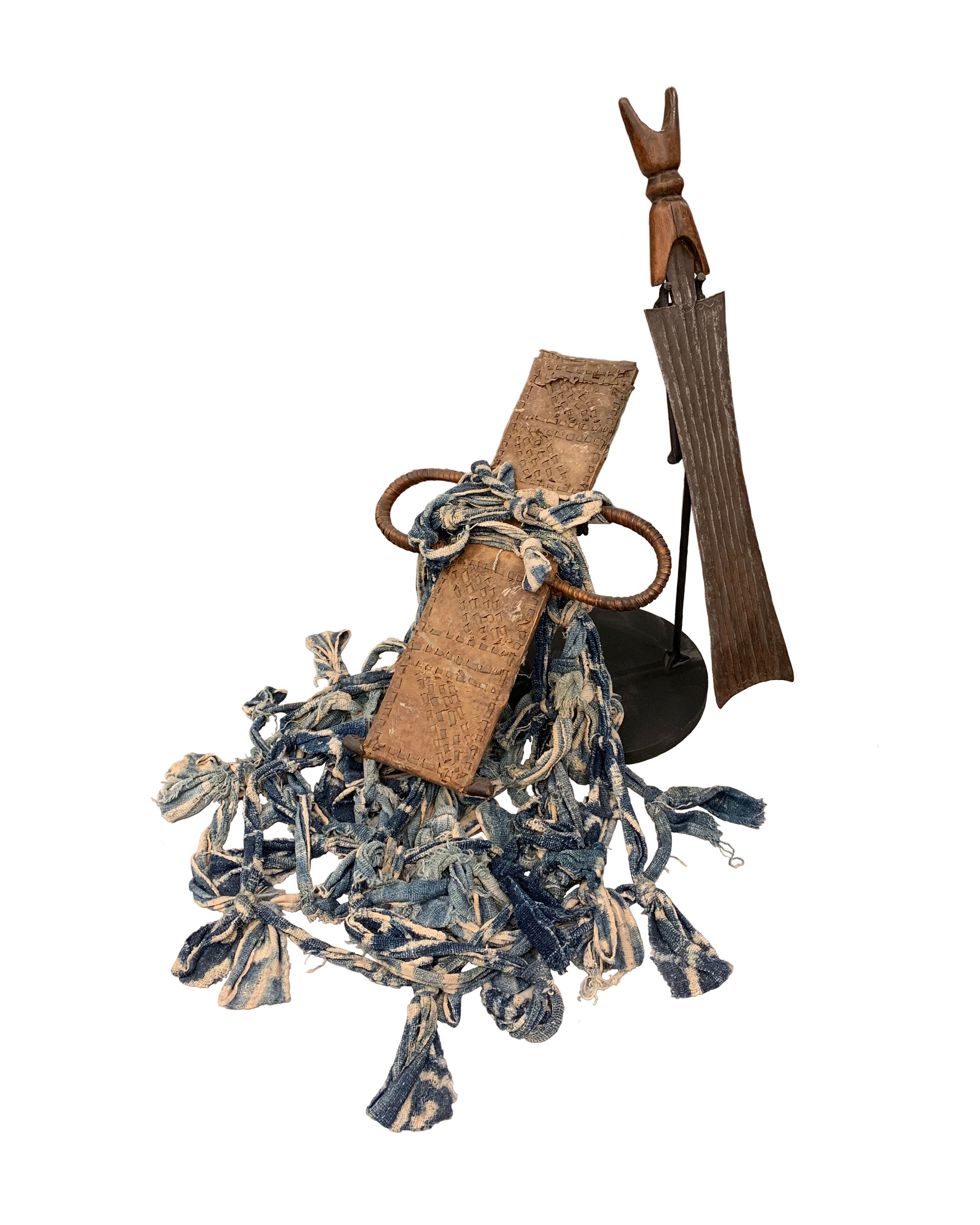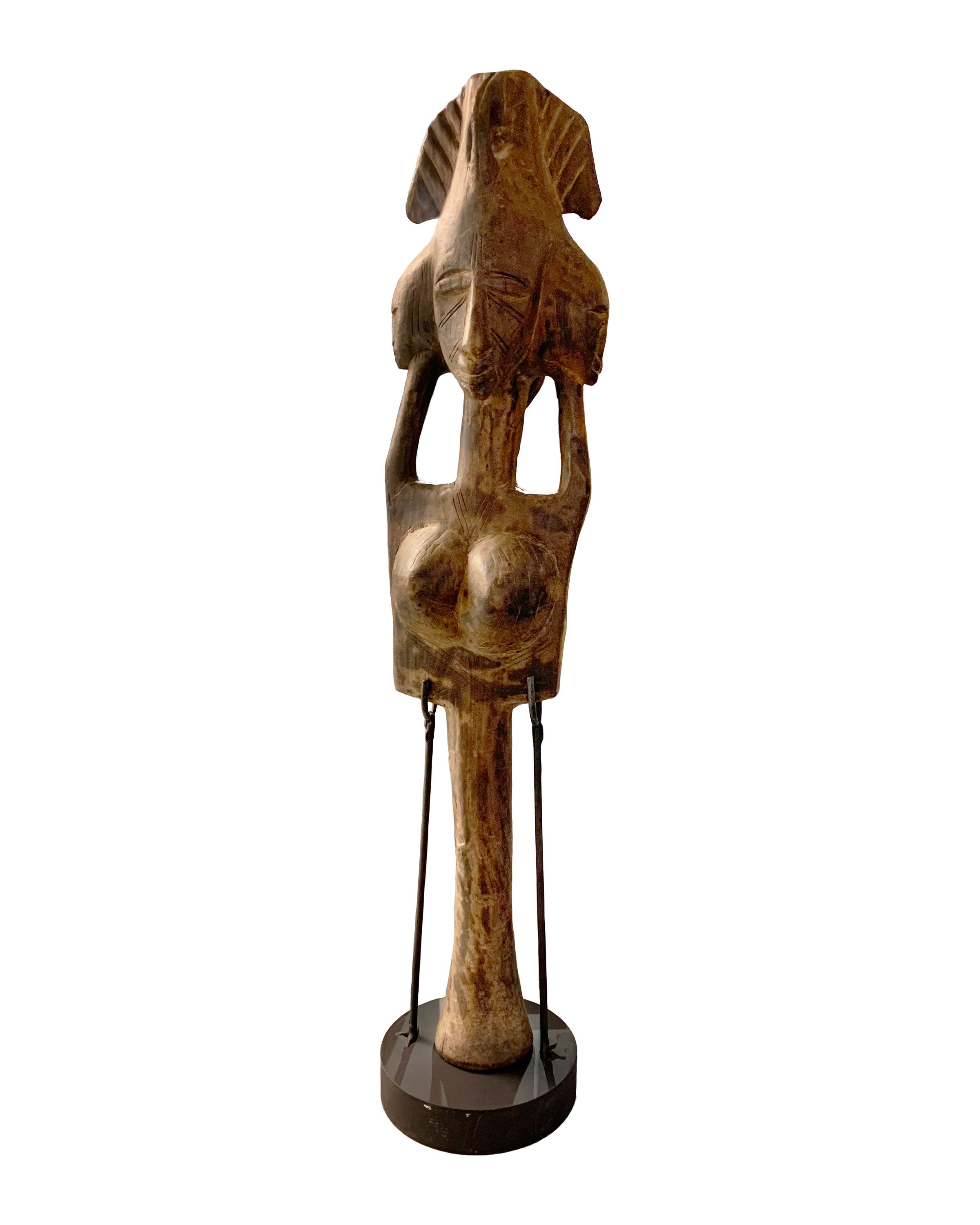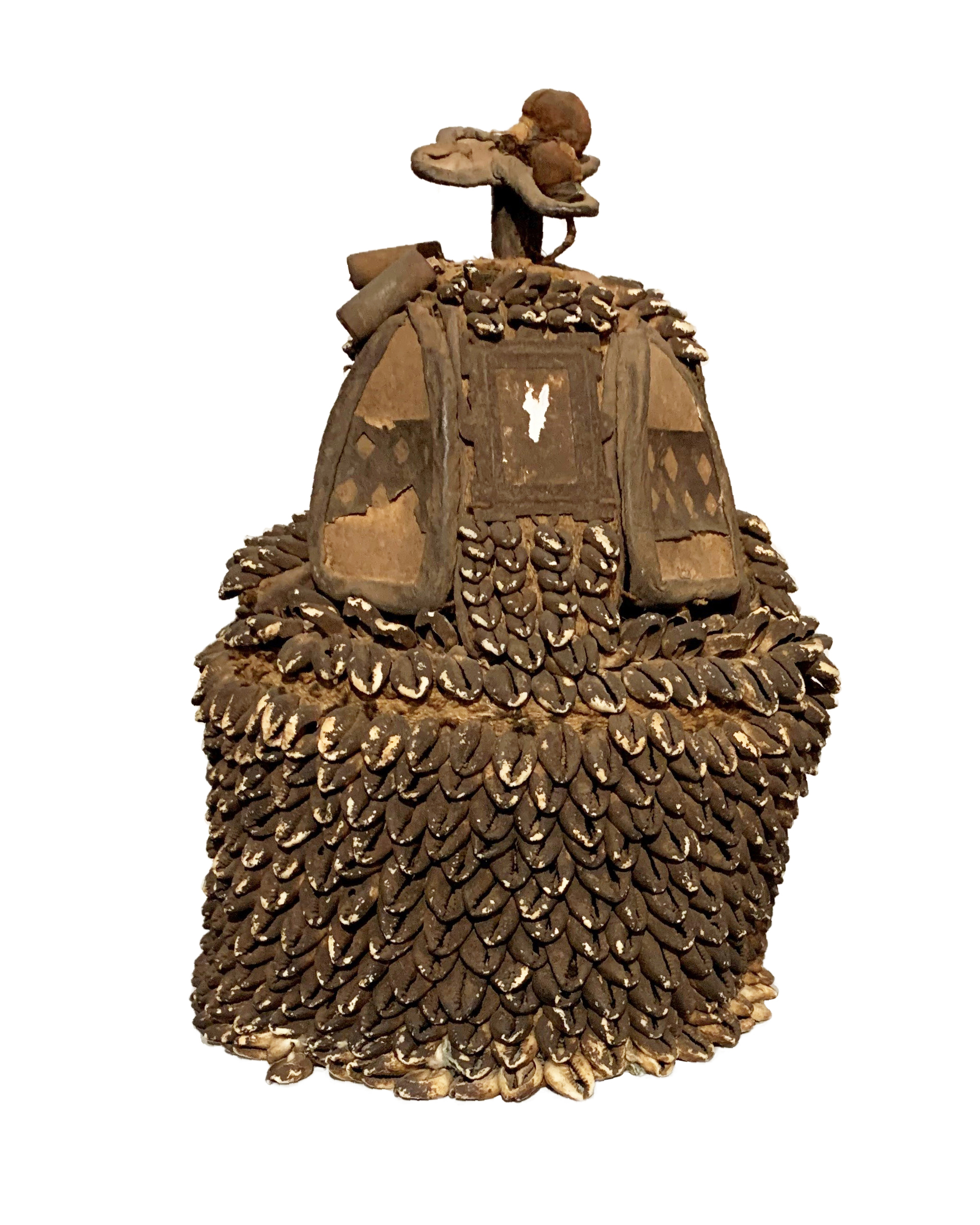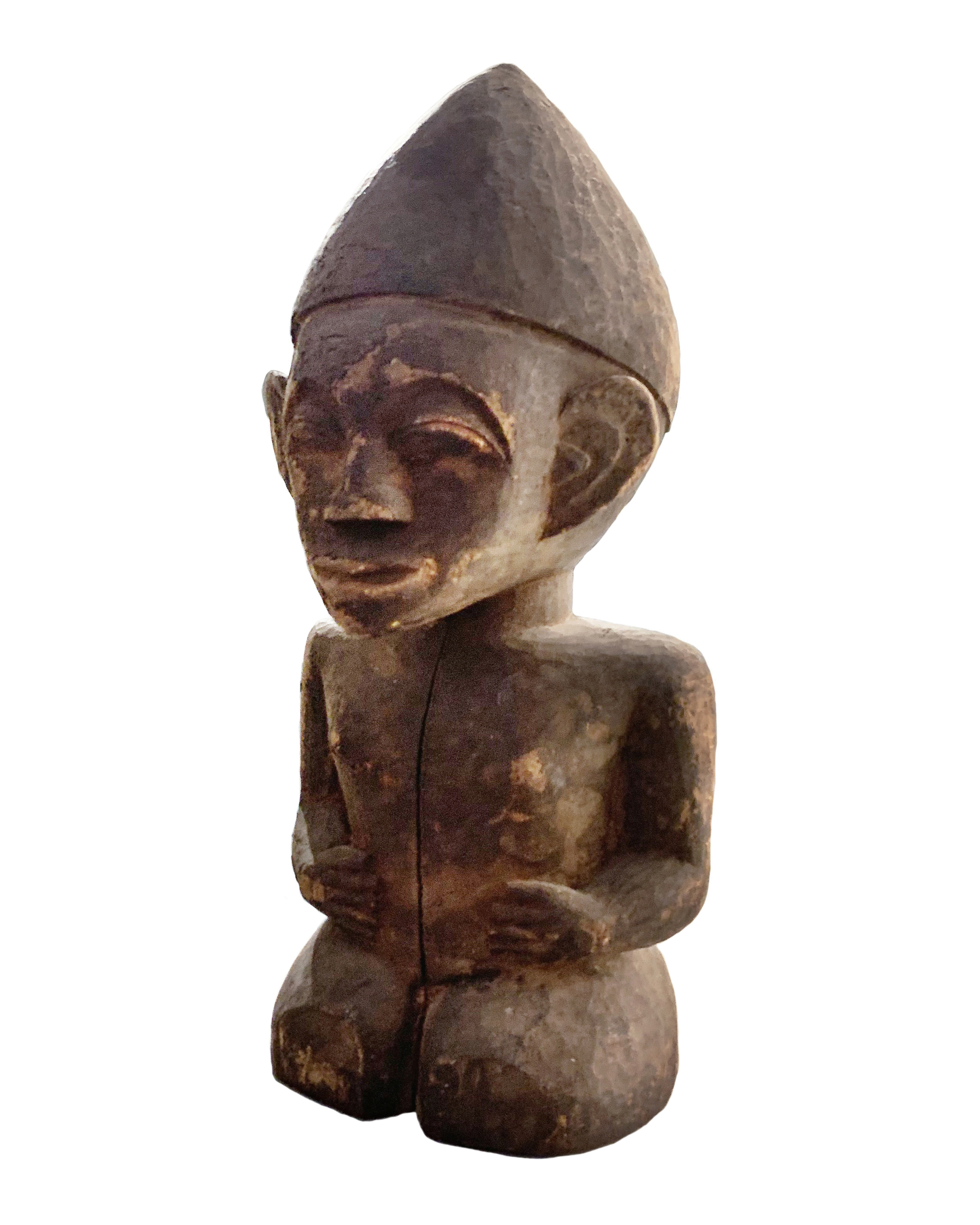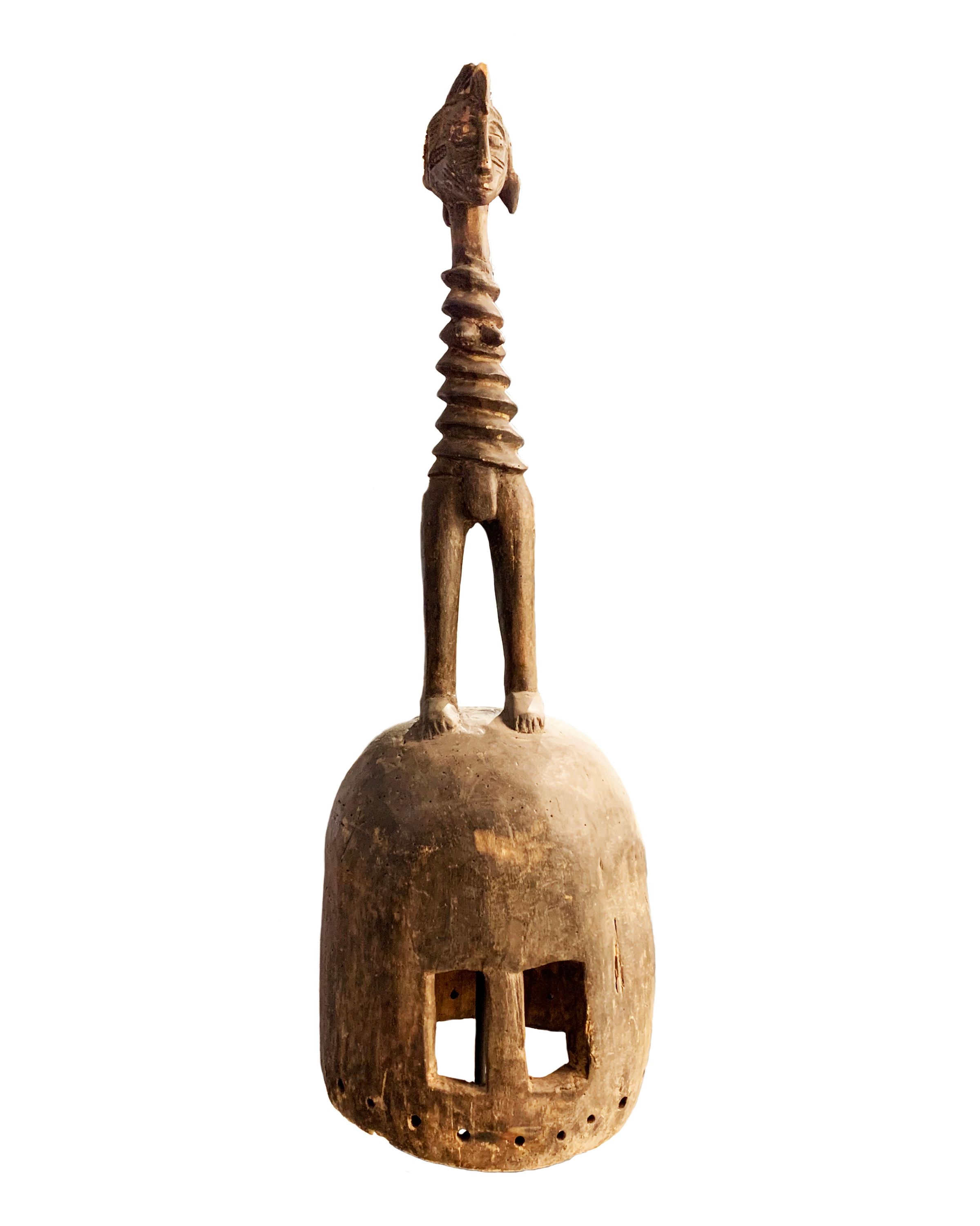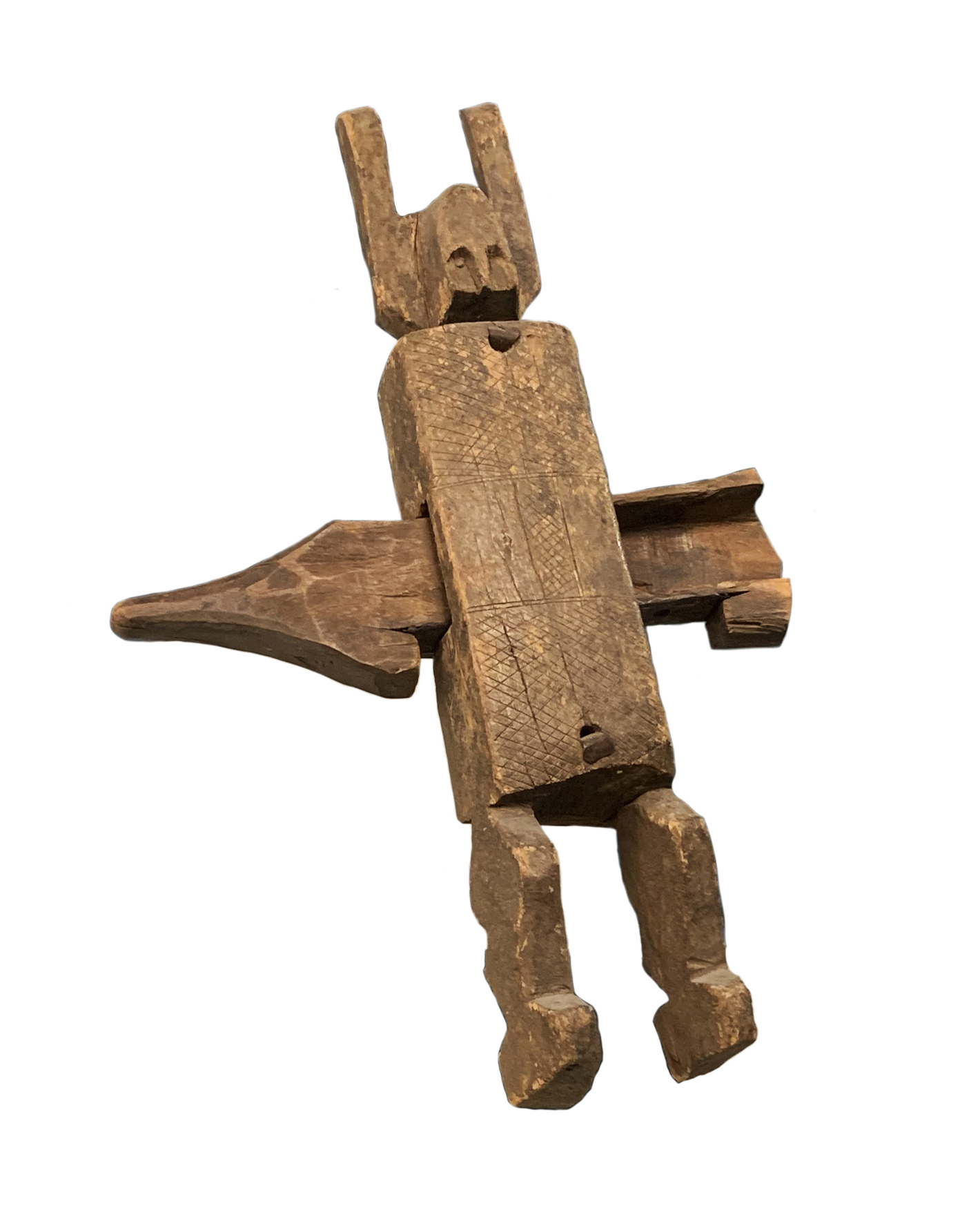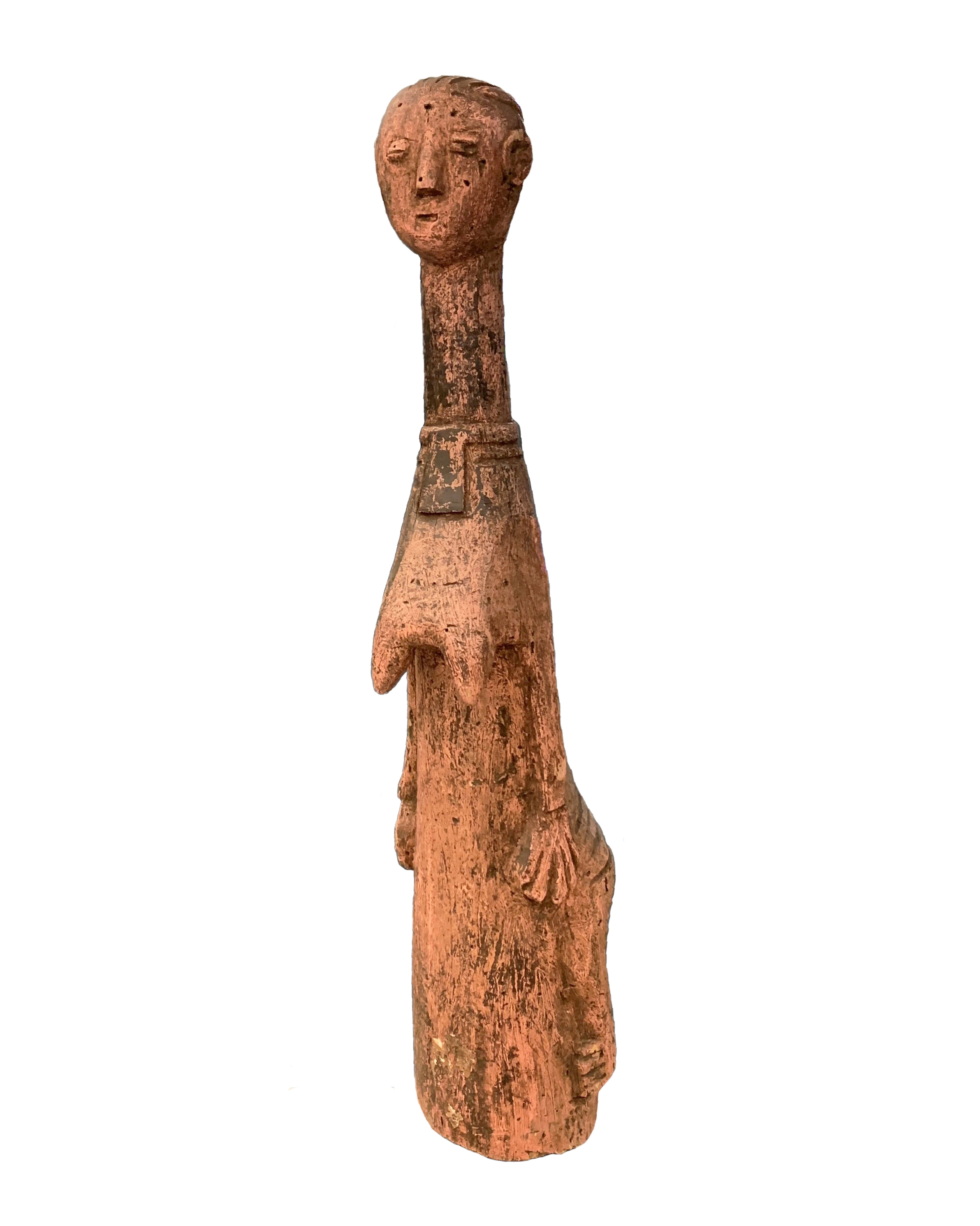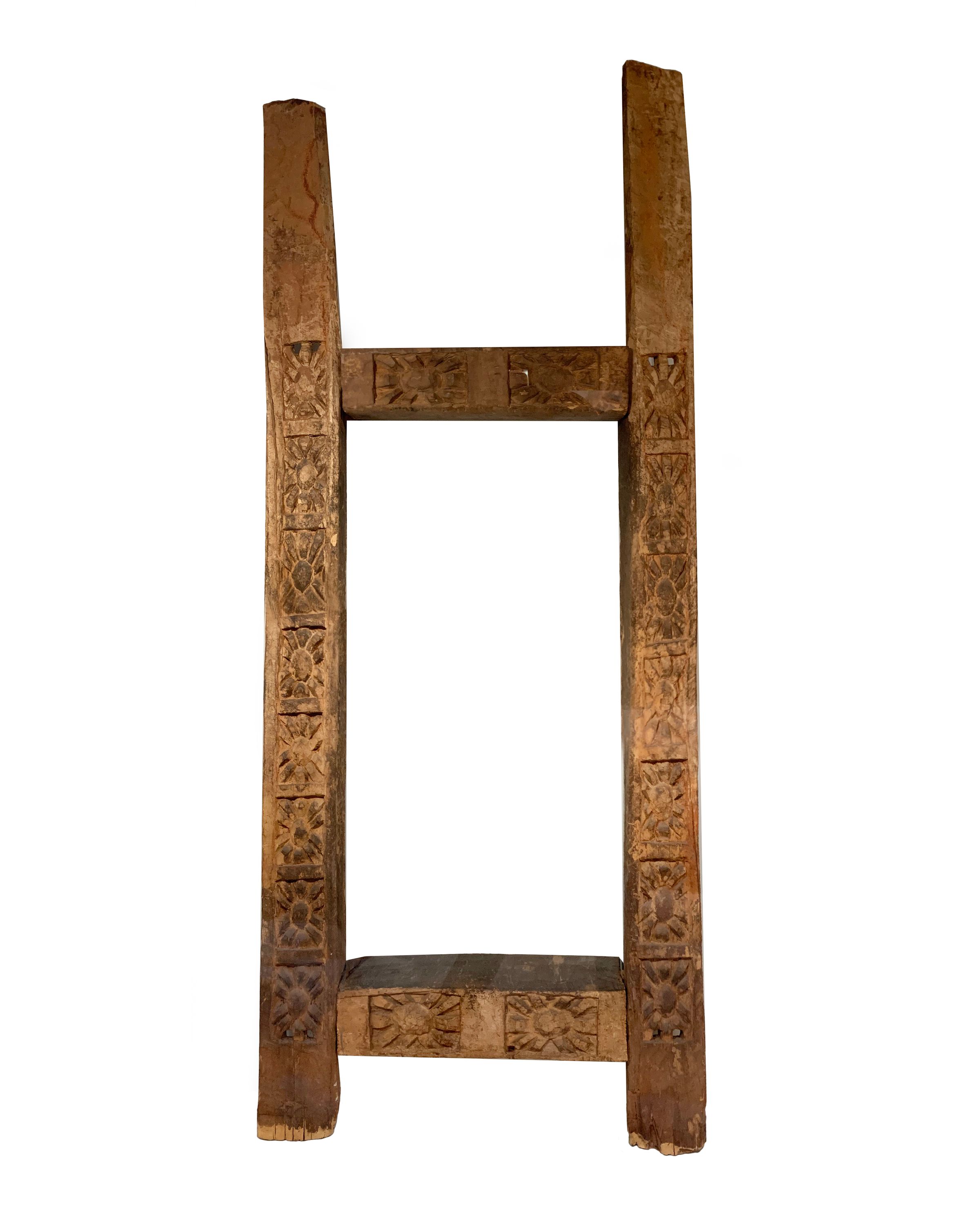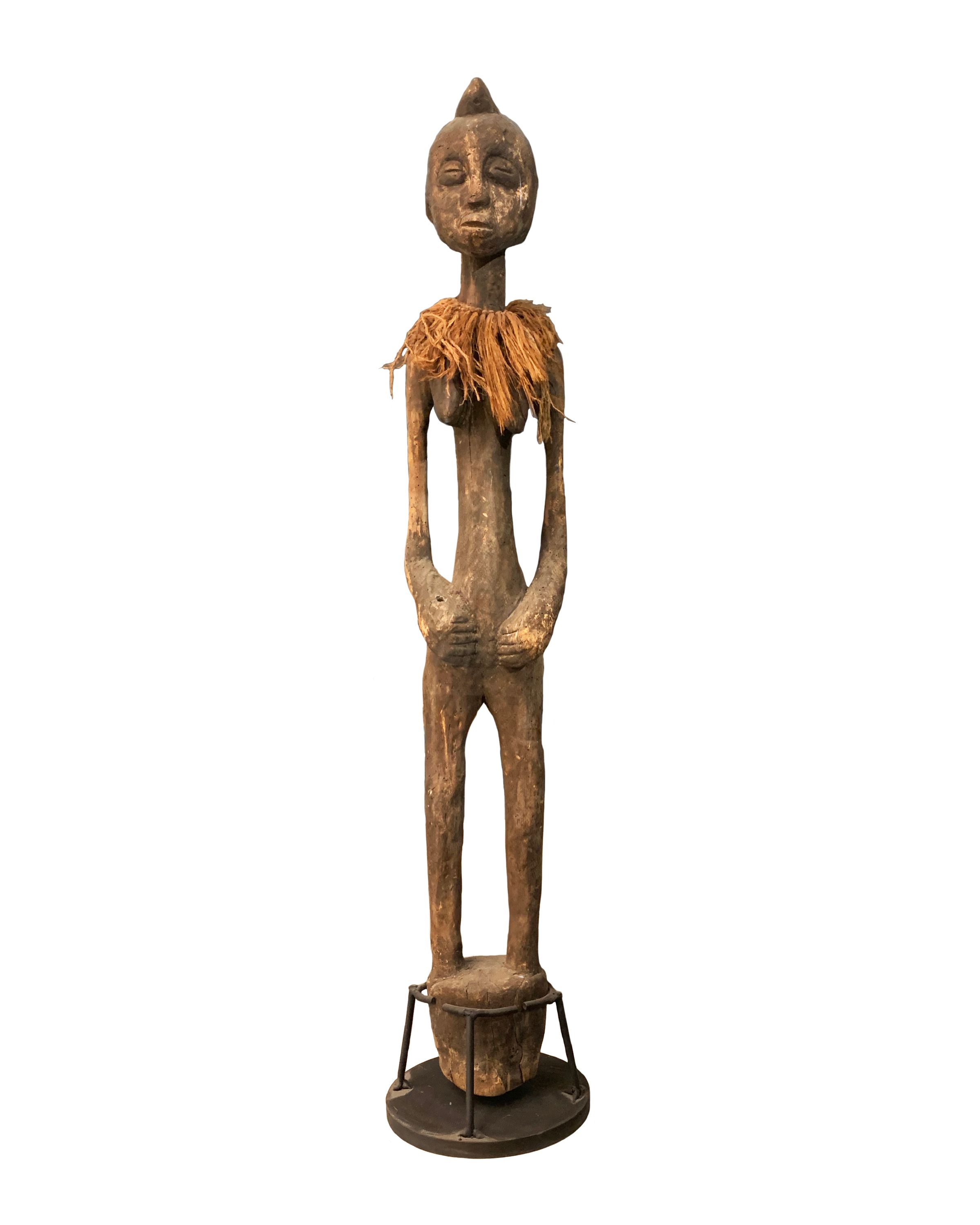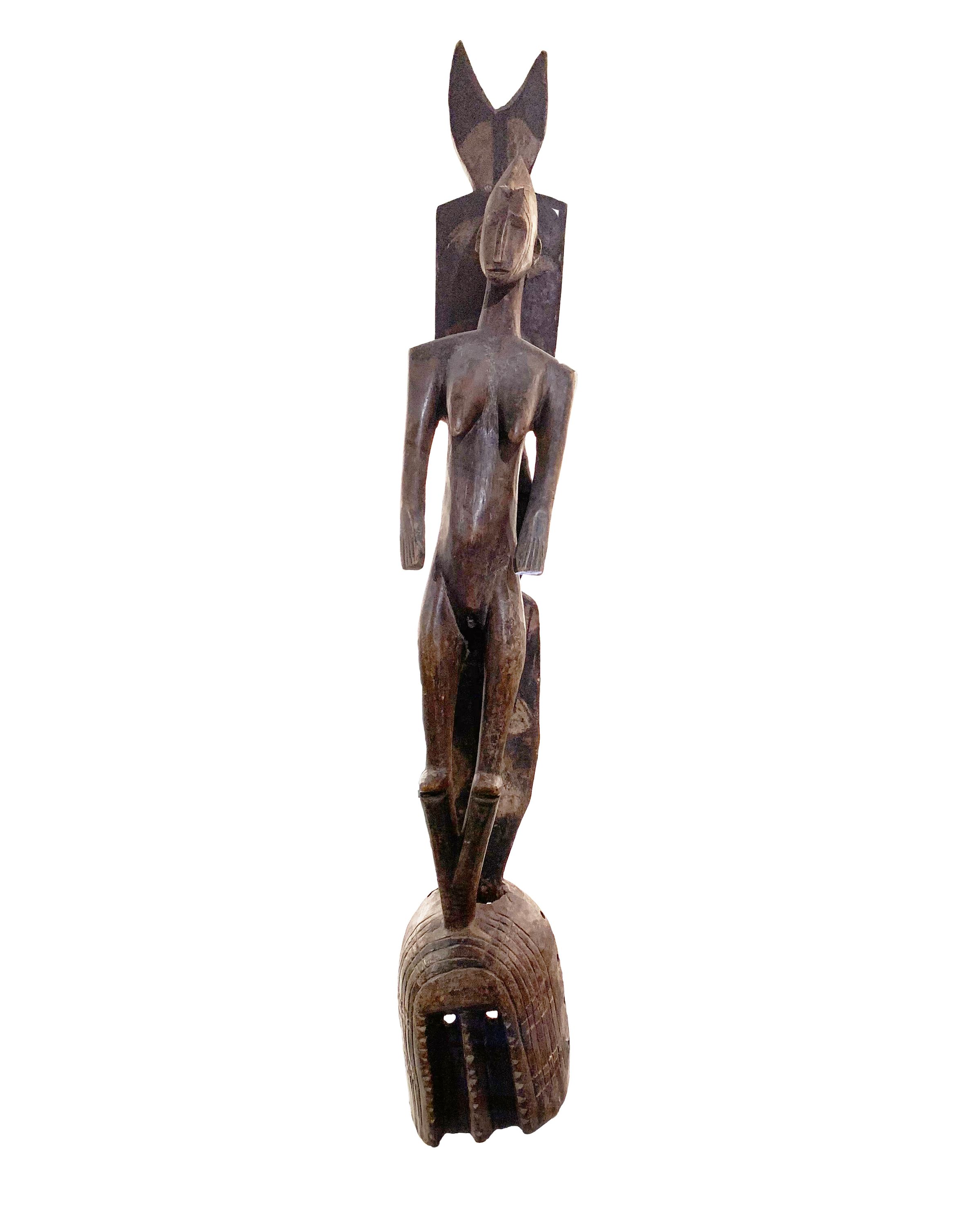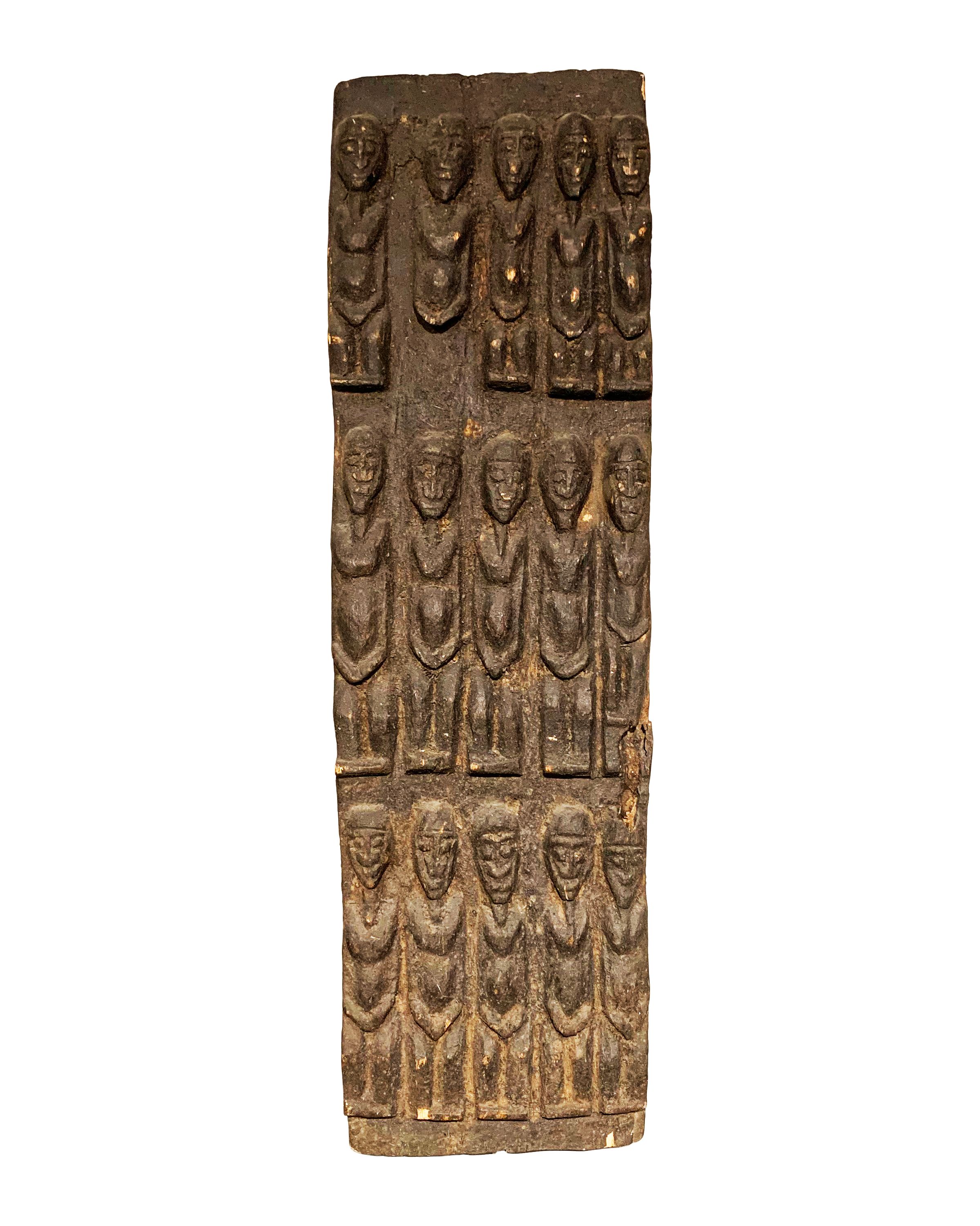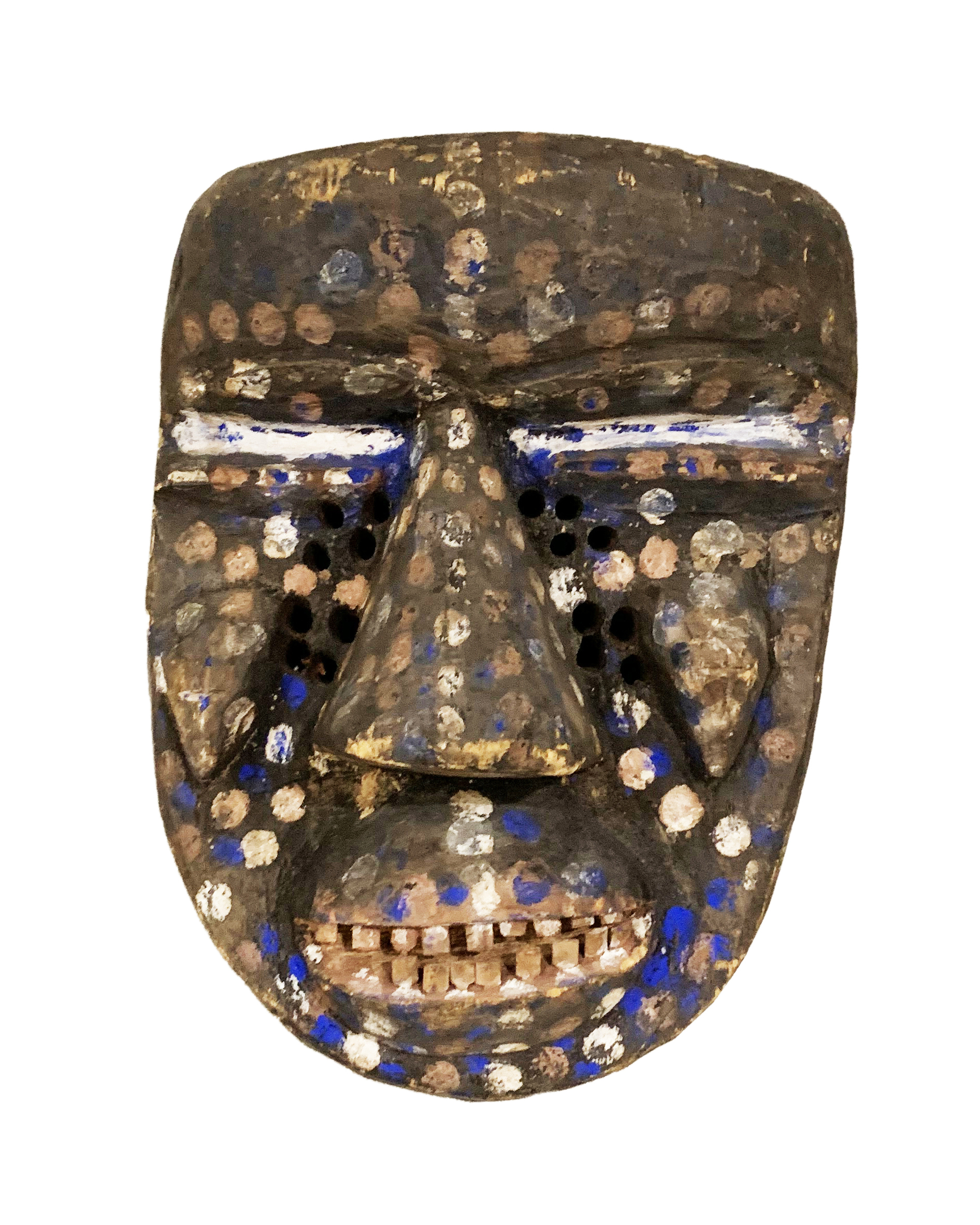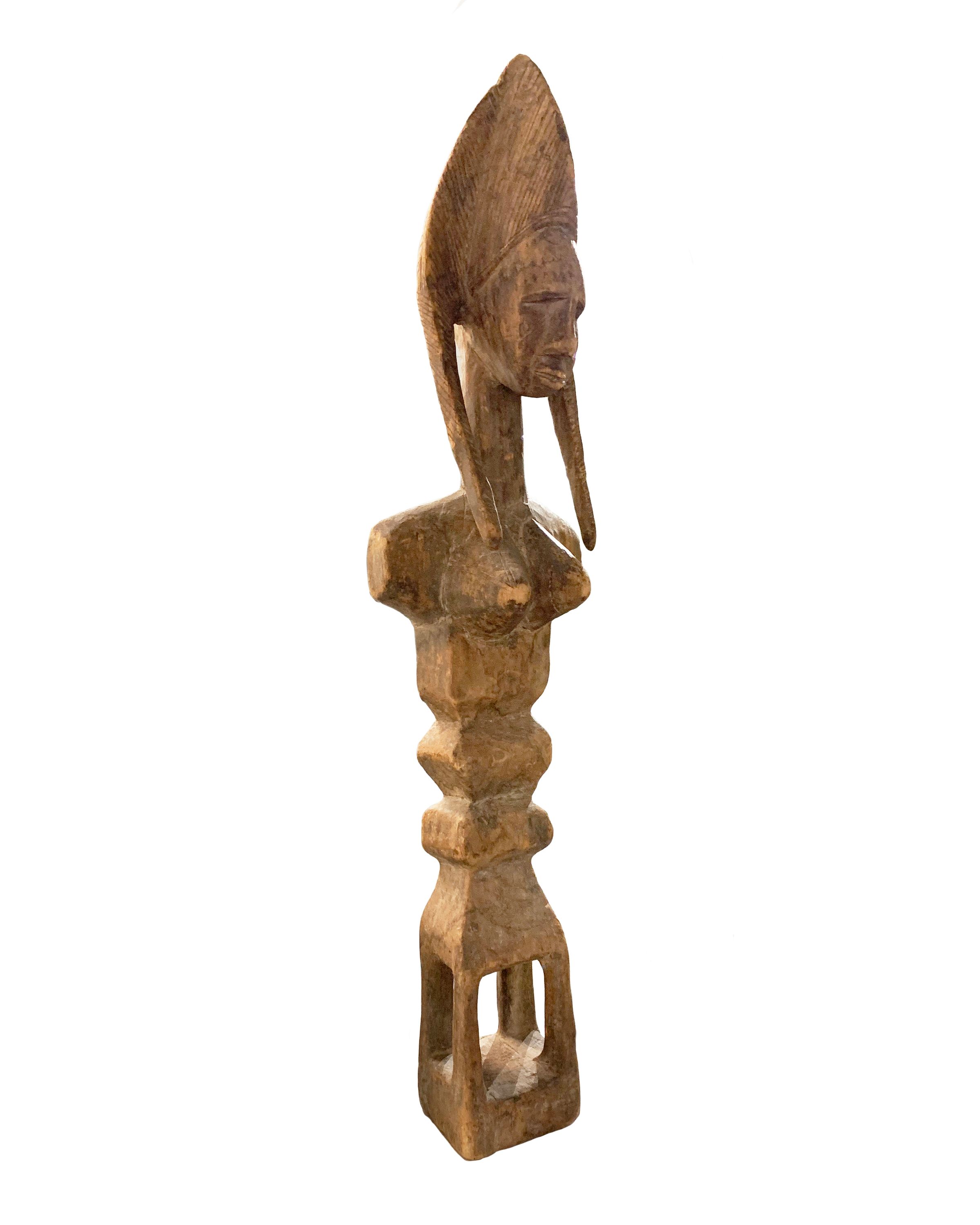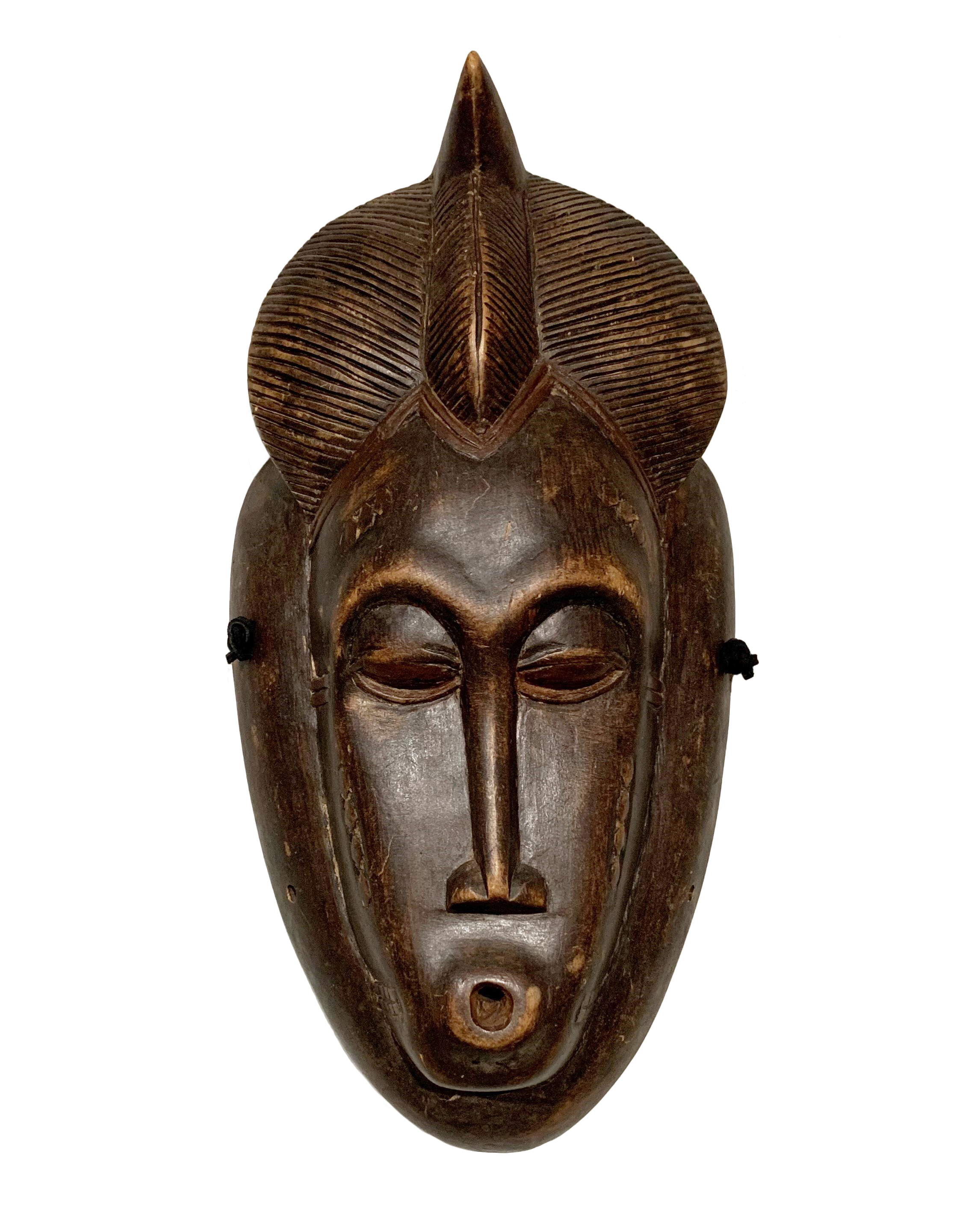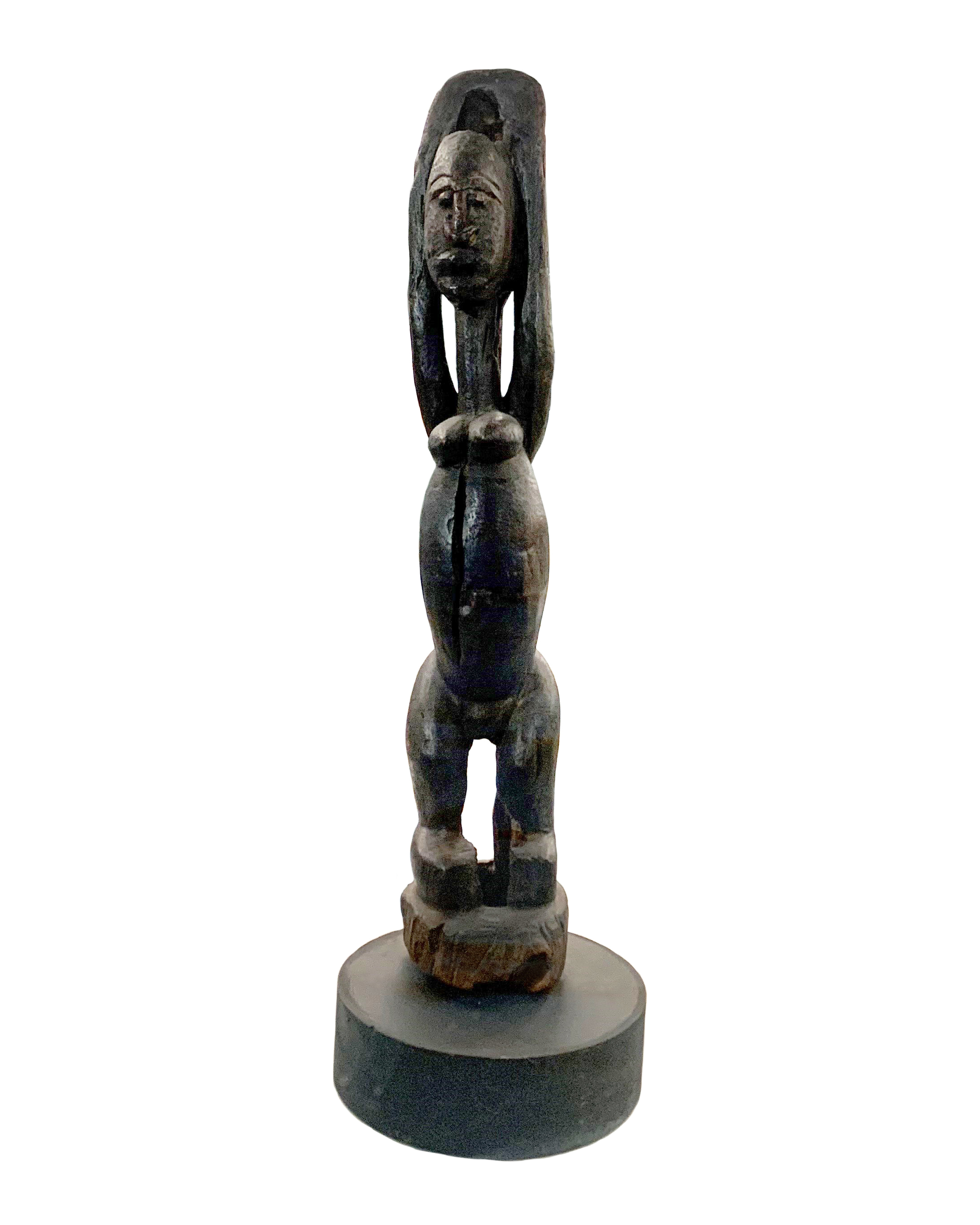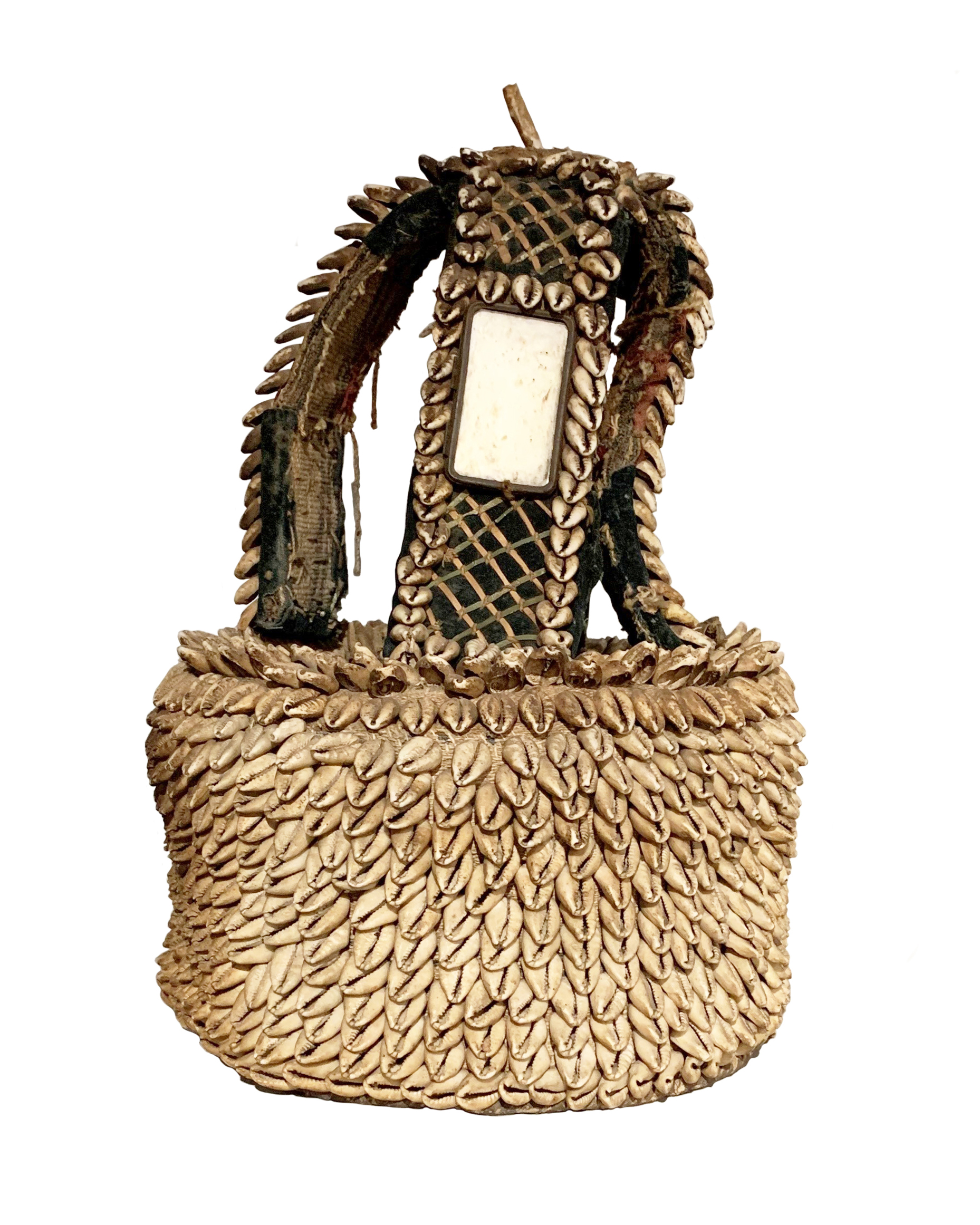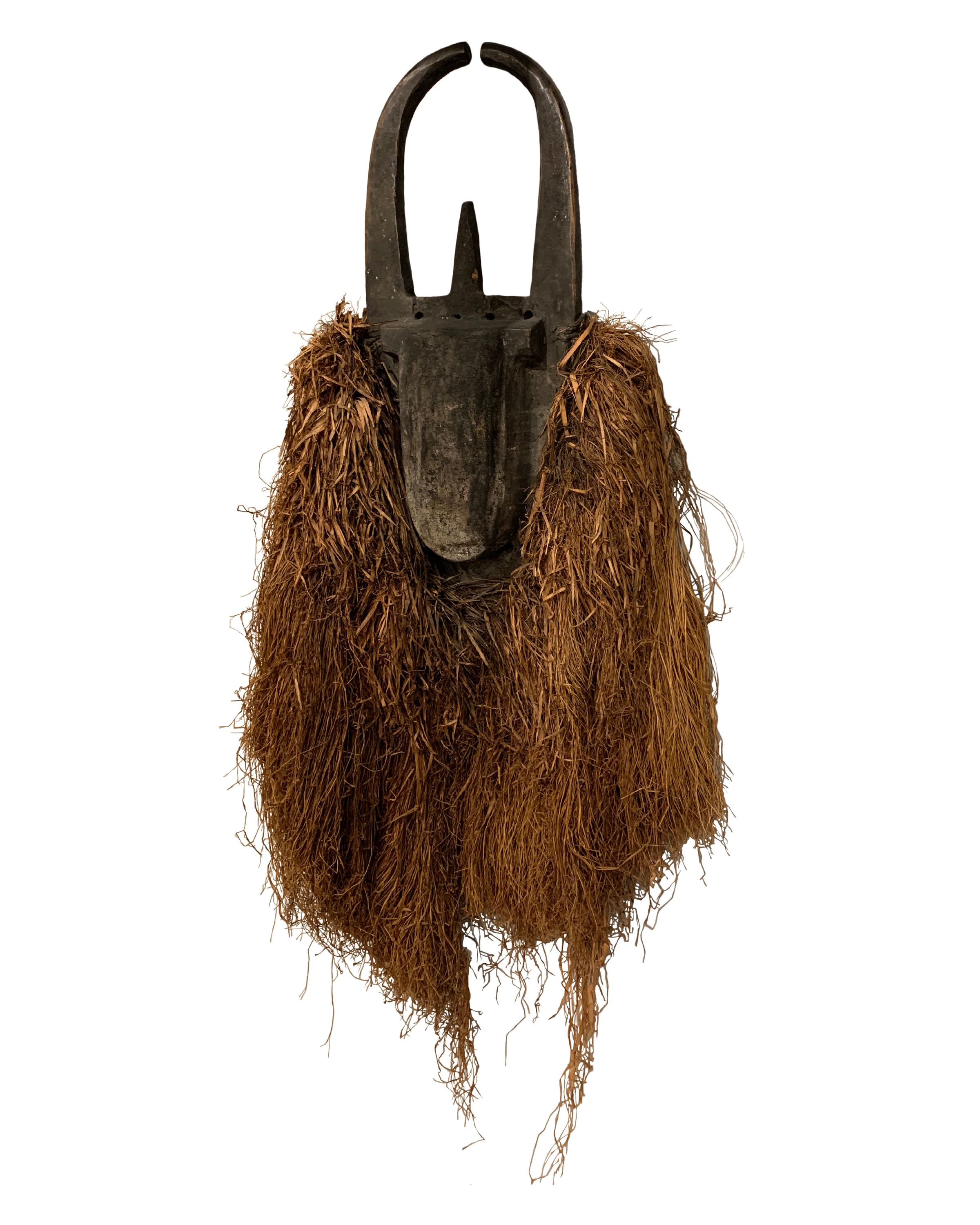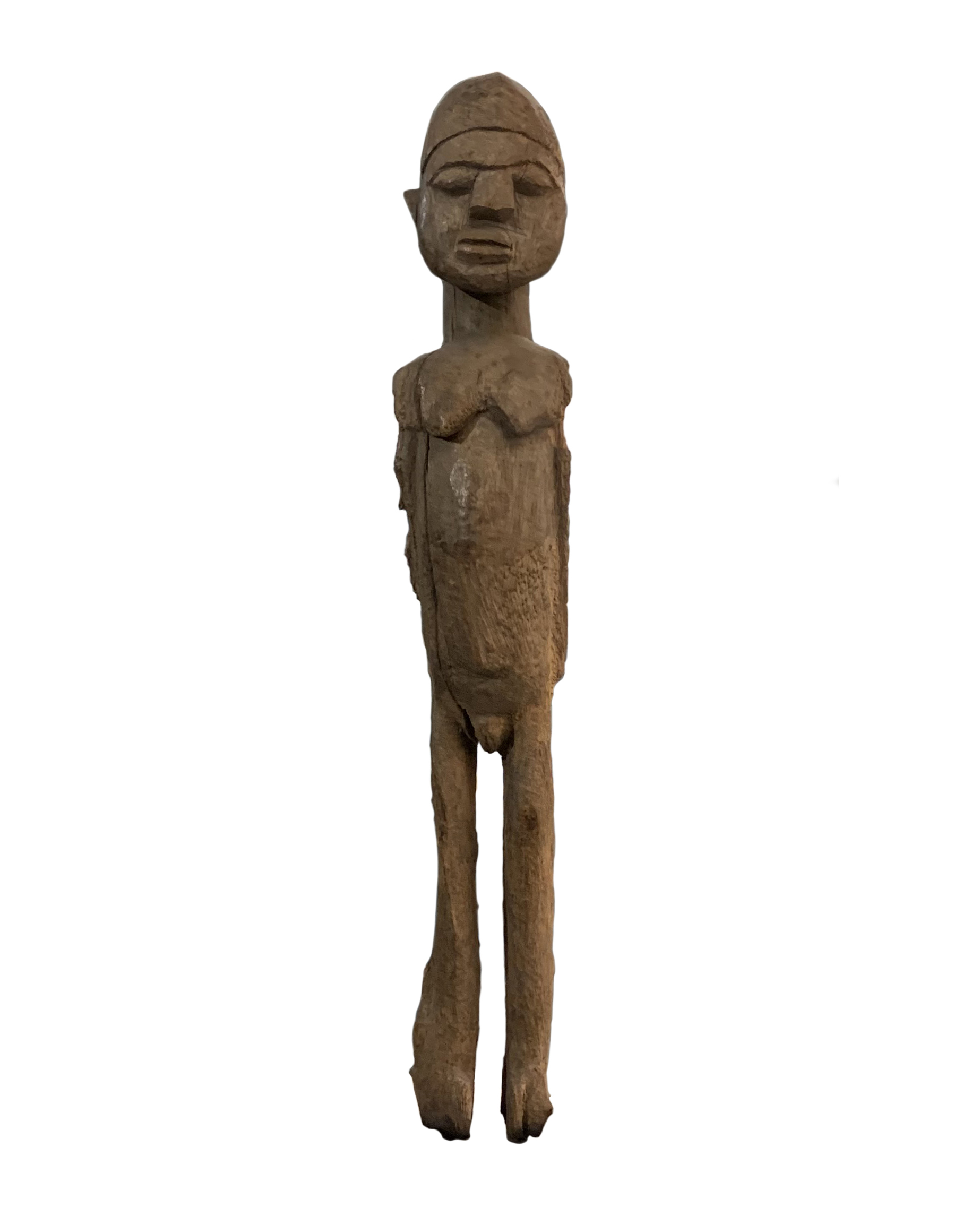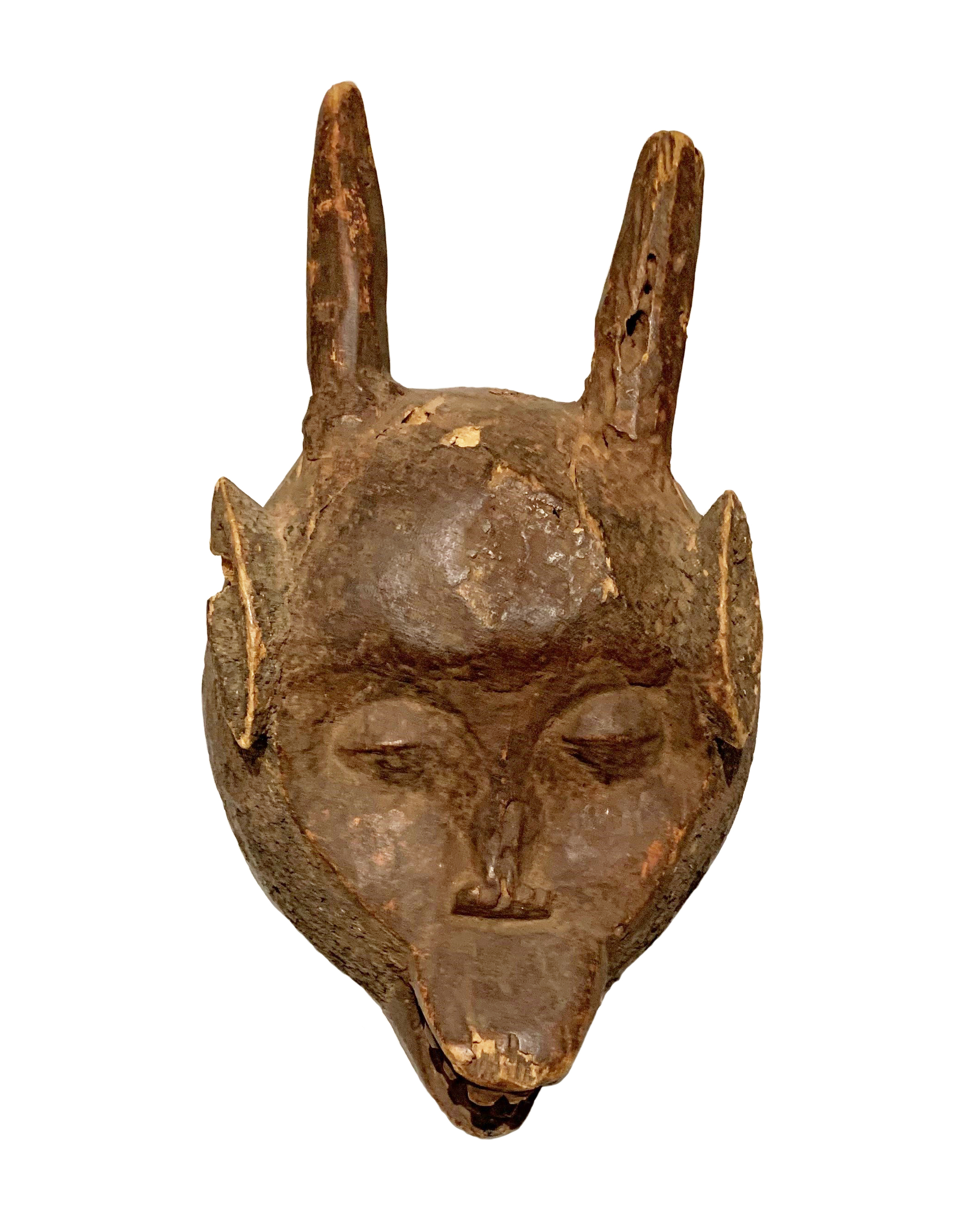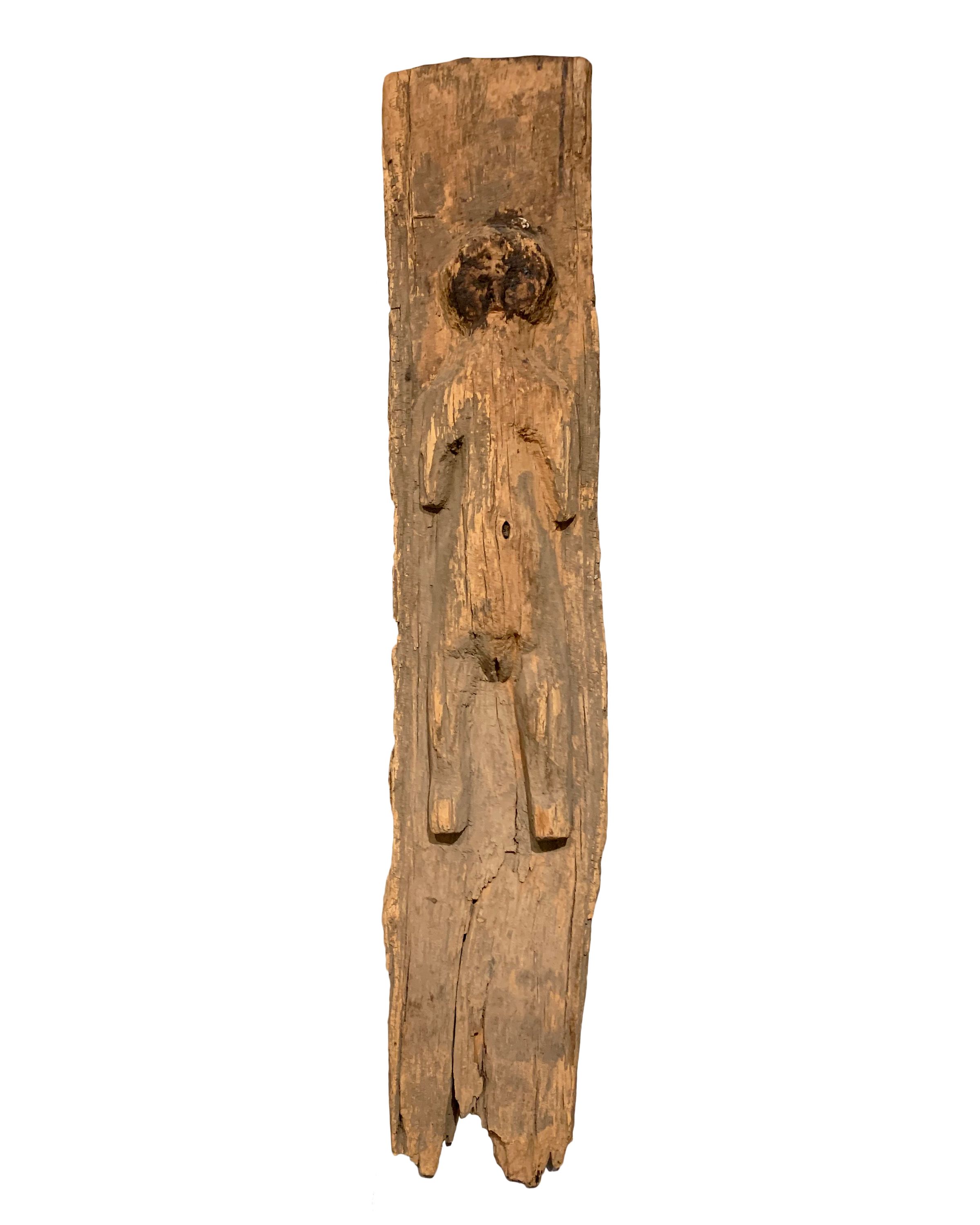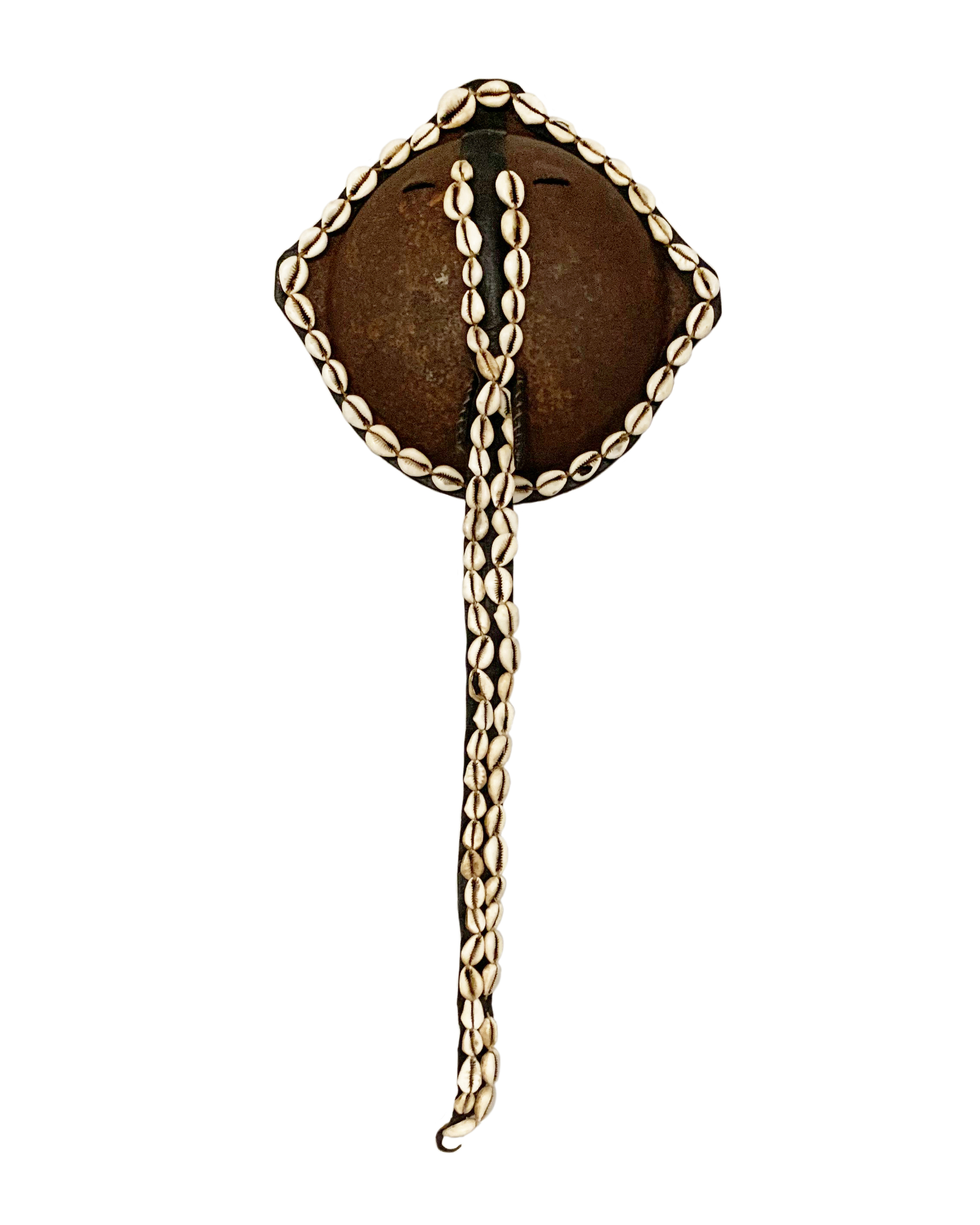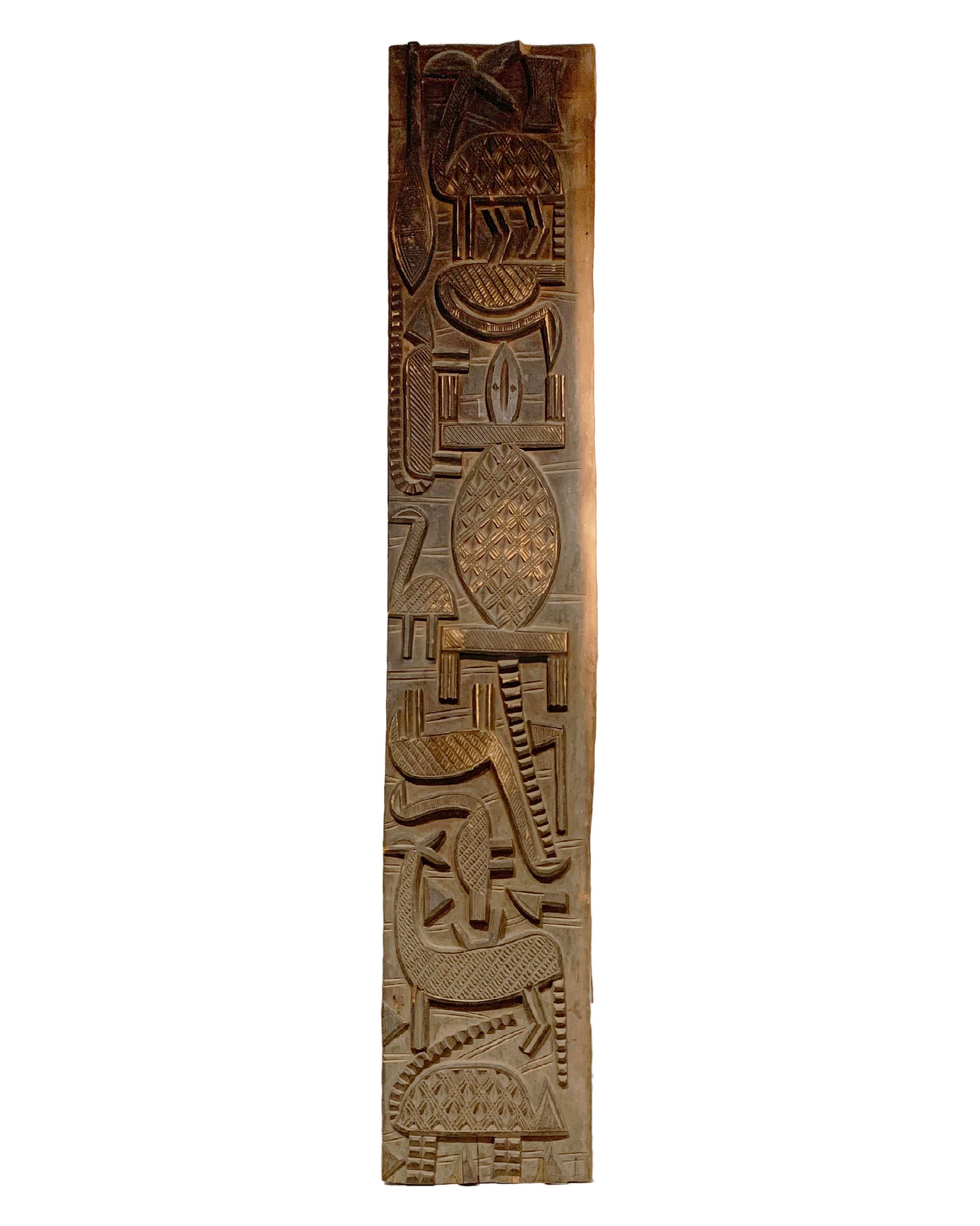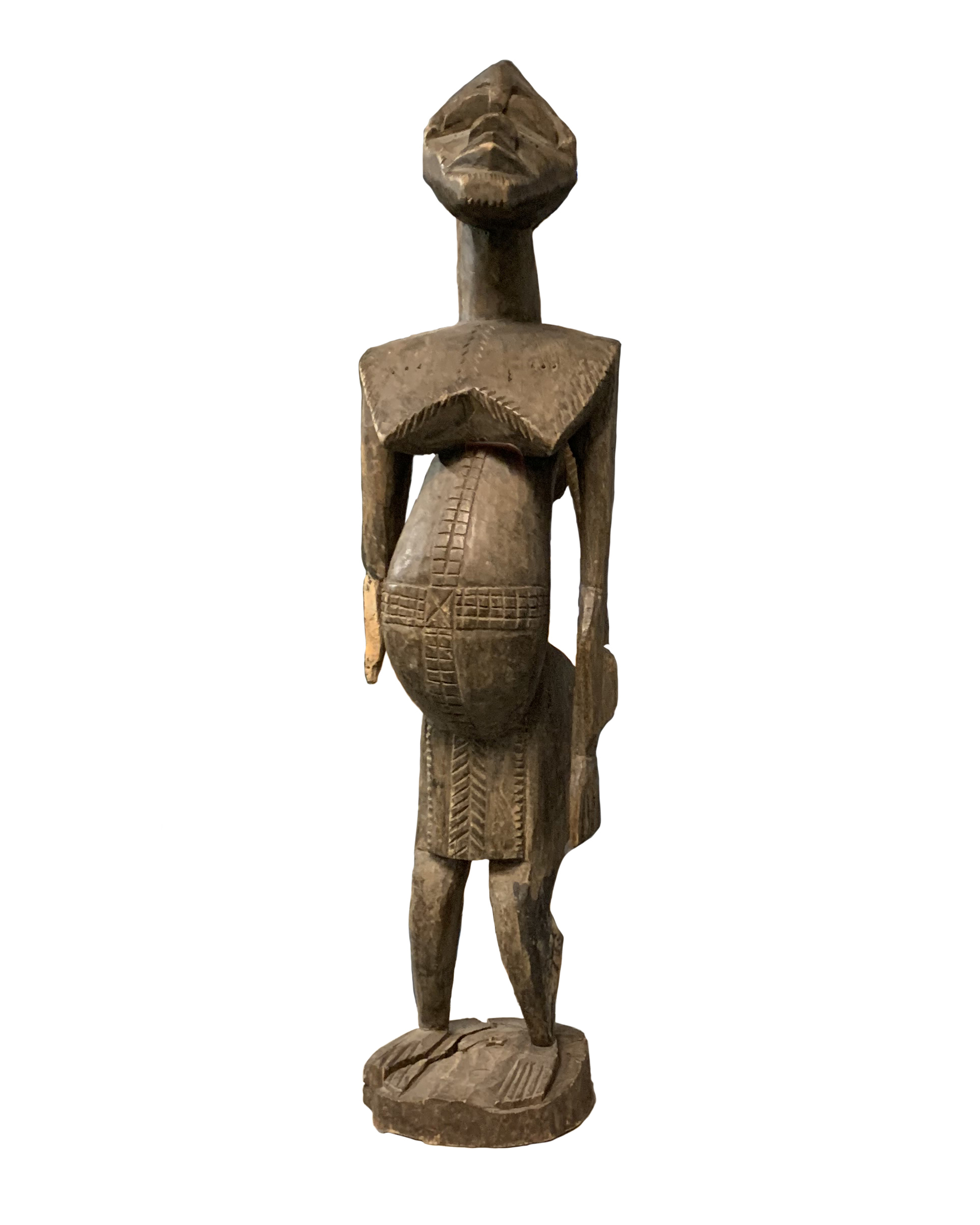African Art Gallery
The African Art Gallery is located in the library in the basement of building 7.
This collection was donated to Sinclair by Campus Architect Peter Capone in 1979. At the time, Mr. Capone was president of Edward Durrell Stone and Associates, architects of the Sinclair campus. The collection consists of 29 pieces representing 12 West African kingdoms from the countries now called Burkina Faso, Cameroon, Côte d'Ivoire, Liberia, Mali, and Nigeria. The exhibit was dedicated in 1982, reinstalled in its current exhibition cases in 1998, and moved to its present location in the library in 2007.
House Post with Figures
Culture: Bamileke
Origin: Cameroon Grassfields
Wood with Pigment
89.5" h. x 6.5" x 1"
1979.1.1 and 1979.1.2
Donor: Peter Capone
Location: LRC Mezzanine
Both of these posts, carved in high relief with human figures representing the royal ancestors, were used to decorate the palace of the Fon (king).
N'Tomo Face Mask
Culture: Bamana
Origin: Mali
Wood
25" h. x 7" x 6"
1979.1.3
Donor: Peter Capone
Location: LRC Mezzanine
N'Tomo is a mutual aid society committed to the social and religious education of uncircumcised young boys. This N'Tomo mask would be worn during the initiation ceremonies or when begging for rice during the dry season.
Basketry Cap and Grass Cloth Mane
Culture: Bamana
Origin: Mali
Hair / Fiber
50" h. x 10" x 3"
1979.1.4
Donor: Peter Capone
Location: LRC Mezzanine
This basketry cap and grass cloth mane is an attachment for a Chi Wara head-dress. It would be worn with a stylized antelope attached to the top and utilized in a dance that symbolizes Chi Wara, a legendary being who taught mankind to cultivate the land with digging sticks. The dance imitates the play of antelopes, calling earth spirits and insuring the fertility of the fields.
Kpeliye'e (Face Mask)
Culture: Senufo
Origin: Côte d'Ivoire
Wood with Metal, Mirror, Cowry Shells
37" h. x 17" x 8.5"
1979.1.5
Donor: Peter Capone
Location: LRC Mezzanine
This mask representing female spirits, is worn by male dancers during rituals associated with Sandogo, a female religious society. The python and chameleon represent the female diviner's spiritual powers. The horns are those of the buffalo. The Senufo word for buffalo also refers to events and medicine that are part of the ceremonial cycle.
Horned Face Mask
Culture: Kran/Guere
Origin: Liberia/Côte d'Ivoire
Wood with String, Hair, Cowries, Paint
16" h. x 7" x 5.5"
1979.1.6
Donor: Peter Capone
Location: LRC Mezzanine
This dance mask would represent an antelope-type character in a village masquerade and has a similar, elegant carving style as the Guro.
Iron Sword and Scabbard
Culture: Bamum
Origin: Cameroon Grassfields
Sculpture
43" h. x 12" x 3"
1979.1.7
Donor: Peter Capone
Location: LRC Mezzanine
This iron sword with wooden handle and leather scabbard would indicate the status of the owner by the amount of decoration on the scabbard. Swords worn by the rulers of grassland kingdoms show the degree of skill achieved by the Tikar blacksmiths who settled in the northern grasslands.
Two-Faced Figure
Culture: Bamana
Origin: Mali
Wooden Sculpture
38" h. x 8" x 7"
1979.1.8
Donor: Peter Capone
Location: LRC Mezzanine
This double-faced figure was possibly used as part of a theatrical performance that included puppets and music.
House of the Head or Ile Ori I
Culture: Yoruba
Origin: Nigeria
Mixed Media
13" h. x 11" x 9"
1979.1.9
Donor: Peter Capone
Location: LRC Mezzanine
The Yoruba believe that the head is the source of character and destiny. This basket-like container with a separate lid would have been used to hold symbols of a person's spiritual essence or individuality. The ibori, or lid, represents the spirit's link to the otherworld.
Seated Male Figure
Culture: Senufo
Origin: Côte d'Ivoire
Wooden Sculpture
13.5" h. x 6" x 6.5"
1979.1.10
Donor: Peter Capone
Location: LRC Mezzanine
This small, encrusted wood figure represents a bush spirit. Once clothed in a sacred cloth called fila, it occupied a place of honor in a diviner's shrine.
Deguele Mask with Figure Crest
Culture: Senufo
Origin: Côte d'Ivoire
Wood
29" h. x 8.5" x 9.5"
1979.1.11
Donor: Peter Capone
Location: LRC Mezzanine
This wooden Deguele helmet mask is part of a pair used along with a male counterpart in the secret ceremonies of the male Poro association. The masks came out at night for the funeral rites of the society's members. The design on the figure represents the symbolic winding sheets that were worn by the dancers and then discarded on the grave as the participants fled.
Carved Door Lock
Culture: Dogon
Origin: Mali
Wood with Steel
20" h. x 12" x 3"
1979.1.12
Donor: Peter Capone
Location: LRC Mezzanine
This carved, two-piece door lock would have been attached to the panels of a granary door. The lock insured physical and supernatural protection.
Female Figure Trumpet
Culture: Bamileke
Origin: Cameroon Grassfields
Wood with Pigment
28" h. x 6" x 6.5"
1979.1.13
Donor: Peter Capone
Location: LRC Mezzanine
This carved wooden trumpet in the form of a female figure was used in funerary ceremonies.
Four-Piece Door Post and Lintel Set
Culture: Bamileke
Origin: Cameroon Grassfields
Wooden Sculpture with Relief
94.5" h. x 39" x 7.75"
1979.1.14
Donor: Peter Capone
Location: LRC Mezzanine
Carved posts and lintels decorated the doorways of the prominent. This four-piece set has relief carvings of highly stylized spiders, which indicate divine knowledge. The spider is seen as a vital link between this world and the ancestors.
Female Poro Figure
Culture: Senufo
Origin: Côte d'Ivoire
Wood with Raffia
42" h. x 7" x 6"
1979.1.15
Donor: Peter Capone
Location: LRC Mezzanine
Sculptures called Debele, short for madebele or 'bush spirit,' are used by dancers to pound the ground in time to a drumbeat. Used by the Poro society, they symbolize fertility or abundance.
Karan-wemba (Face Mask)
Culture: Mossi
Origin: Burkina Faso
Wood with Pigment
39.5" h. x 6.75" x 5.5"
1979.1.16
Donor: Peter Capone
Location: LRC Mezzanine
Karan-wemba masks represent a female ancestor spirit who returns to earth to ensure that rites are properly carried out. They are stored in the clan house, occasionally brought out to serve as altars and honor deceased elders.
Granary Door
Culture: Dogon
Origin: Mali
Encrusted Wood
28.5" h. x 8.5" x 1"
1979.1.17
Donor: Peter Capone
Location: LRC Mezzanine
Granaries were located in the courtyard of the principal residence of the extended family. Used to store surplus crops, the doors were covered with rows of male and female twins repeated in series and symbolized fertility and ongoing abundance. They insured physical and supernatural protection.
Dan Mask
Culture: Dan
Origin: Liberia
Wood with Pigment and Reed
10.5" h. x 8.5" x 6"
1979.1.18
Donor: Peter Capone
Location: LRC Mezzanine
Dan masks vary in style and use. The more exaggerated masks represent male forest spirits and are often covered with fur, feathers, and horns. They're used in lively performances meant to teach proper behavior.
Stylized Female Sculpture
Culture: Unknown
Origin: West Africa
Wood
34" h. x 8" x 5"
1979.1.19
Donor: Peter Capone
Location: LRC Mezzanine
This piece is similar to the male and female pairs known as "children of Poro," the highly stylized lower portion may have held charms or natural/spiritual materials.
Portrait Mask
Culture: Baule
Origin: Côte d'Ivoire
Wood
13" h. x 6.5" x 4.5"
1979.1.20
Donor: Peter Capone
Location: LRC Mezzanine
The scarification and style of hairdressing on this mask are indicative of a specific individual. Portrait masks were used in Mblo dances where dancers representing animals or humans would culminate the dance by honoring the community's most admired member.
Female Altar Figure
Culture: Dogon
Origin: Mali
Blackened Wood
19" h. x 3" x 3.5"
1979.1.21
Donor: Peter Capone
Location: LRC Mezzanine
The posture of the figure suggests a way of communicating with a deity. The arms over the head indicate that the worshiper is praying for rain.
House of the Head or Ile Ori II
Culture: Yoruba
Origin: Nigeria
Leather, Cloth, Cowries, Mirrors
13" h. x 11" x 9"
1979.1.22
Donor: Peter Capone
Location: LRC Mezzanine
This basket-like container made of leather, cloth, cowries, and mirrors would have been used to hold symbols of a person's spiritual essence or individuality. Cowrie shells, ancient currency of the area, indicate material well-being.
Horned Mask
Culture: Toma
Origin: Liberia
Wood with Leather, Raffia, Natural Materials
60" h. x 24" x 6"
1979.1.23
Donor: Peter Capone
Location: LRC Mezzanine
The horns on this piece are indicative of the water buffalo. The mane is made of raffia, a material from the forest. It is used to dress spirits and is believed to have protective properties.
Female Dogon Figure
Culture: Dogon
Origin: Mali
Wood
19" h. x 3.5" x 4"
1979.1.24
Donor: Peter Capone
Location: LRC Mezzanine
Dogon figures served as the temporary abodes of recently deceased relatives. Shrine altars were located in the house of the lineage head and figures were displayed on the roof during funerals of the wealthy and powerful.
Cap Mask
Culture: Bamana
Origin: Mali
Encrusted Wood
14" h. x 7" x 4"
1979.1.25
Donor: Peter Capone
Location: LRC Mezzanine
This cap mask is in the form of a horned animal with open mouth and bared teeth may have been used by the Kore society. There, ceremonial masks representing different animals were used to comment on proper or improper behavior. Masquerades took place at initiations, at rain invoking ceremonies, and at harvest.
Post with Relief Carving
Culture: Dogon
Origin: Mali
Wood, Mud, Cowrie Shell
45" h. x 8" x 6"
1979.1.26
Donor: Peter Capone
Location: LRC Mezzanine
This carving is possibly a support post from a Dogon Togu na, a large, low open structure with a massive roof made of millet stalks, which were the physical and symbolic center of the community. The posts were carved and painted with masks, body parts, and mythological characters. This figure may represent a Nommo, one of the eight ancestral spirits who founded the Dogon lineages and introduced weaving, smithing, and agriculture to their human descendants.
Mask Headdress
Culture: Unknown
Iron with Leather, Cowries
9.5" h. x 9.5" x 13"
1979.1.27
Donor: Peter Capone
Location: LRC Mezzanine
This mask headdress of discoid form is a highly stylized representation of an elephant and may have been used as a cap mask or as ornamentation.
Nupe Door Panel
Culture: Nupe
Origin: Nigeria
Wood
72.5" h. x 14" x 1.5"
1979.1.28
Donor: Peter Capone
Location: LRC Mezzanine
This door panel with reliefs of humans, animals, tools, and patterns was carved by Sakiwa the Younger of Lapai, Nigeria. The Islamic woodcarving tradition, passed to the Nupes, is found in embellished doors created for the houses of the Fulani ruling class. The doors usually consist of three or four joined panels.
Standing Female Figure
Culture: Unknown
Wood
20.5" h. x 5.5" x 5"
1979.1.29
Donor: Peter Capone
Location: LRC Mezzanine
This carved sculpture is a female figure of unknown origin. The scarification on the abdomen, the frontal pose, and attitude are similar to Yoruba, Dogon, and Mossi figures.
